

Iowa grapples with mass deportations
Local immigrant groups and law enforcement offices prepare for potential arrests.
Roxy Ekberg
Politics Editor roxy.ekberg@dailyiowan.com
Kate Perez Senior Reporter news@dailyiowan.com
Brought into the U.S. by her mother in 1992, Gabriela Palacios immigrated from Mexico City, Mexico.
After Gabriela had built a family in the U.S., she had to return to Mexico, traveling to Juarez to obtain the required paperwork, complete several appointments, and pass exams to gain legal citizenship status.
Going to Mexico meant Gabriela was separated from her three sons as she tried to gain legal status in the U.S.
The immigration process is difficult both emotionally and financially, she said, and can separate families for extended periods of time. Gabriela was away from her sons for over a year, and she did not gain legal status until 2012.
Gabriela said she is deeply upset about President Donald Trump’s immigration policies. “It makes me upset because I’m a mother. I have kids and I don’t like to see kids suffer, parents suffer, mothers suffer,” she said. “They feel fear. They feel stressed about what’s going on.”
Gabriela said some immigrants in the Iowa City community are afraid to go out in fear of Trump’s mass deportations. The Washington Post reported a sharp drop in consumer spending from Latino communities as a result of this fear.
Blitzed by a flurry of immigration reform policies, Iowa City immigrants and law enforcement are navigating Trump’s sweeping executive actions.
Utilizing U.S. Immigration and Customs Enforcement, or ICE, and multiple federal agencies, Trump has launched his promised effort to round up and deport millions of unauthorized immigrants, starting with people accused of violent crimes.
According to data posted by ICE on X, formerly known as Twitter, the agency arrested more than 8,000 people between Jan. 22 and Jan. 31. It also issued over 6,500 “detainers lodged” for people arrested by other law enforcement agencies whom ICE believed were eligible for deportation.
This is an average of 828 arrests and 658 detainers lodged per day. ICE began beefing up enforcement with raids in Chicago and other cities. The threat of ICE knocking on doors looms large over immigrant communities, including those in Iowa City.
Rumors of deportations and ICE have spread through local Iowa communities, leaving feelings of unease and fear in their wake.
Escucha Mi Voz providing support
Escucha Mi Voz, a faith-based, immigrant-led, community organization in Iowa City, is providing resources and educational programming to immigrants in the community who may be impacted by the sweeping deportation orders.
This programming and events range from classes that teach people English to legal advice information to participating in protests — all of which have happened since the initial announcement of the executive order.
Clare Loussaert, a second-year student at the University of Iowa, has been volunteering with Escucha Mi Voz for the past five years. In August 2024, Loussaert began working as an organizer for the group, meaning she organizes the programming that aims to aid immigrant communities in Johnson County.
One prominent move of support that took place recently was the creation of a protective escort for immigrants required to meet with ICE in Cedar Rapids, Loussaert said. In a press release about the event shared with The Daily Iowan, Escucha Mi Voz stated that “immigrants who have been paroled into the United States or are waiting for their immigration court dates are required to check-in periodically with ICE.”
There were three immigrant families with a total of 11 individuals scheduled for check-ins. Over 100 volunteers accompanied the families while they waited outside for their appointments, passing out hot coffee to people in line.
These escorts have happened before and are a way to help immigrants feel safe during what could be a nerve-wracking experience, Loussaert said.
“We brought 100 people to the ICE office
UI students find work in nail art
College students have found a way to earn extra cash in the dorms.
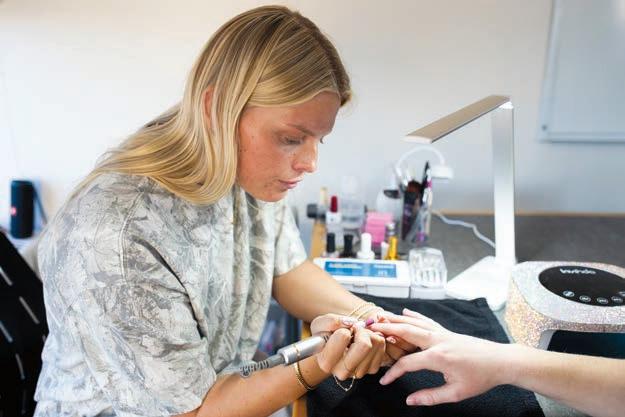
Grace Olson News Editor grace.olson@dailyiowan.com
Sitting at a table splayed with UV lights, and a rainbow of polishes and brushes, University of Iowa first-year student Charlie DeGroot had meticulously arranged her station. As I sat down for our appointment, I showed her a design I found after hours spent scouring Pinterest, and, like some kind of magical nail technician genie, she deftly pulled out the exact colors and got to work.
Gently holding my hands in hers, DeGroot carefully examined the length of each fake nail she had just finished adhering. After ensuring they matched up just right on each finger, she flipped the switch to turn on her drill and began filing down the edges of the fake nails to make them blend seamlessly with the rest of my natural nails.
DeGroot applies this kind of care to all of the many nail appointments she has weekly, students flocking from all corners of Iowa City to the fourth-floor lounge of Rienow Residence Hall.
What started as a hobby and way to save cash for the first-year student has blossomed into a legitimate side hustle, making DeGroot roughly $700 a week. The Cedar Rapids native said in high school, she only ever had her nails done at salons for special occasions such as homecoming or prom, but she quickly fell in love with the feeling of having her nails done and wanted to learn how to do her own to avoid frequent and expensive trips to the salon. Aside from doing her own nails, DeGroot now sees the practice as a chance to earn a steady income between her classes.
“It’s hard to have a job here,” she said. “This is just a super comfortable job where I roll my cart down the hallway and do people’s nails and talk to them. I’m not someone that wants to ask my parents for money forever. They already paid for my school.”
From her baseline price of $40 per Gel-X set, a press-on with gel polish, or
IC’s new lounge is the cat’s meow
Kitty Corner Social Club will bring new feline friends in mid-to-late February.
Riley Dunn Digital Editor riley.dunn@dailyiowan.com
Nestled just across the street from the Pentacrest, the Kitty Corner Social Club will be sinking its claws into Iowa City in mid-to-late February.
The city’s first-ever cat lounge aims to provide a unique and comfortable space where community members can sit back, relax, and enjoy the comfort and connections provided by cats. Through a partnership with the Iowa City Animal Care and Adoption Center, visitors of the lounge will also have the opportunity to adopt some of the new furry friends they make.
“Iowa City is the perfect place to pull on this thread of humanity and animal love and compassion,” Kitty Corner founder Katy Brown said. “Everyone needs their cortisol levels lowered a bit in this day and age.”
Upon walking through the front door of Kitty Corner, which stands in the former V’s Nail Studio location, guests will be greeted with colorful feline-inspired wallpaper and decorations, as well as toys and space for cats to roam freely.
They will then be instructed to remove their shoes for the safety of the cats and given a sticker denoting the hour when their time is up. Twelve cats will be ready and available to play with and pet at any one time.
People will have the opportunity to enter the lounge for 15 minutes if they pay $11, 30 minutes for $15, or 60 minutes for $22. In addition, there will be private event packages available for purchase.
“I’m cat-obsessed and missing my cat while at college, so I’ll definitely check this out,” University of Iowa second-year student Kathryn Schultz said. “Cat people are some of the best people.”
Schultz plans on visiting Kitty Corner soon after it opens and hopes the presence of cats there will provide her with love and warmth while she is away from her own household cat.
The idea for Kitty Corner first took root after Brown and her family visited a cat lounge in Paris. Once back in Iowa, Brown made arrangements to meet the owner of Coffee Cats, a popular cat cafe in West Des Moines that serves beverages in the presence of feline friends.
During this conversation, Brown was able to think through logistics and formulate a
John Charlson | The Daily Iowan
University of Iowa student Charlie DeGroot styles Daily Iowan News Editor
Grace Olson’s nails inside of Rienow Residence Hall on Jan. 28. DeGroot is majoring in business.
Illustration by Marandah Mangra-Dutcher | The Daily Iowan
in Cedar Rapids to accompany some families to their ICE check-in appointments. And so we use that as an opportunity to show up and make sure that they came out of their check-ins,” Loussaert said.
The organization has also trained around 400 people with “know your rights” programming, which educates immigrants on their rights while living in the U.S. The organization has split the education process into multiple sessions: a meeting in Spanish that around 200 people came to and two other calls with English speakers with around 100 participants in each.
At the Spanish meeting, the organization also had three lawyers who were able to provide 40 immigrants with free legal consults, Loussaert added.
“[We’re] really just trying to prepare people if they encounter ICE, and just with that, continue to organize and fight back,” she said.
Looking forward, Loussaert said Escucha Mi Voz is focused on getting its Rapid Response team organized so it can communicate new developments, services the the organization offers, membership, and events to its WhatsApp group of nearly 600 immigrants. It also continues to use its legal aid fund and microloan program to aid people financially, she said.
Right now, Escucha Mi Voz is focused on being forward-thinking and organized so it doesn’t have to be reactive in the future, Loussaert said.
“We’re doing our best to be proactive. You know, we were super active during Trump’s first term. So, we have an idea of things that we can do. But also, of course, just paying attention to new developments we already have. We’re fortunate that we’ve, over the years, built a really strong base, so that’s just something we’re continuing to strengthen and expand,” she said.
Loussaert said she believes immigrants deserve as much dignity and support as anyone else, and they are essential workers in the way they aid the functioning of the economy. She added the organization has seen a lot of engagement since the order was announced, and people want to help others, which is heartening.
“One silver lining is that this has really inspired people to act and get organized and make change,” Loussaert said. “So, we’re just really doing our best to feed off the energy and, as organizers, hear what people are willing to do and just get groups together and keep having people show up to events and find other people in the community that are willing to join us.”
IC immigrants fear Trump’s plans
Nationwide, protesters have rallied against Trump’s immigration policies, decrying mass deportations and recent ICE enforcement actions.
More than 150 people clogged the streets of downtown Iowa City on Feb. 3 during a demonstration against Trump’s immigration policies.
Gabriela and her husband Marcelo Palacios participated in Iowa City’s demonstration against Trump’s deportations.
The couple said they are

Demonstrators march during an immigration protest in downtown Iowa City on Feb. 3. Dozens of demonstrators danced, sang, chanted, and marched throughout the early evening. A handful of counter-protesters were in attendance.
angry about Trump’s plan and fearful of the fallout of mass deportations and potential ICE presence in Iowa City.
Gabriela and Marcelo continue to advocate for an end to the detainments and deportations.
Marcelo is concerned about the rhetoric from Trump and his administration about immigrants. He said lumping in all people who have immigrated to the U.S. with the few who have committed crimes is unfair and damaging.
Government data obtained by ProPublica and The Texas Tribune reveals that less than half of the approximately 8,200 people arrested from Jan. 20 through Feb. 2 so far have criminal convictions.
“We always get stereotyped because of Mexico and the cartels and all that,” Marcelo said. “One bad apple ruins the whole tree.”
Marcelo said Trump is trying to pump fear into communities, and he protested to exemplify the strength of immigrant communities.
but under Trump’s recent revocation of the TPS program for Venezuelans, she is at risk of losing everything she has worked toward.
D’Angelo’s protected legal status is set to expire in September 2025, months before she will finish her doctorate program. If she is forced to go back to Venezuela before finishing the program, she won’t receive her Ph.D.
She traveled to Colombia in November to renew her Venezuelan passport because she needs a valid passport to pursue legal immigration. The trip resulted in her losing her status as an international student.
She was told the wait to receive her new passport would be roughly 20 days, yet three months later she is still waiting.
“I took a risk, and right now I don’t even know if it was worth it,” she said.
Rumors of deportation, ICE spark concern
Fears around deportations heightened after the circulation of a video on social media of Iowa State Patrol vehicles in Johnson County on Jan. 21. Escucha Mi Voz received multiple calls reporting potential ICE vehicles following the circulation of the video that reported similar cars around the county, including at the West Liberty Police Department.
Joshua Hauser, West Liberty chief of police, told the The Daily Iowan on Jan. 22 the presence of state patrol vehicles at the police department was unrelated to the mass deportations occurring across the country at the time.
writing that the Sheriff’s Office’s focus and priority continues to be public safety and the protection of crime victims.
“Our job is to enforce the laws of the State of Iowa faithfully and impartially. We reinforce this mindset through the culture we’ve built in the workplace and through the policies that lay out the expectations and manner in which we do our jobs. We have worked hard to build trust across the county and throughout the communities we serve; we will always work in the direction of trust,” Kunkel wrote.
Managing Editor, Print Marandah Mangra-Dutcher marandah.mangra.dutcher@ dailyiowan.com
Managing Editor, Visuals Cody Blissett cody.blissett@dailyiowan.com
News Editor Grace Olson grace.olson@dailyiowan.com
Asst. News Editor Evan Watson evan.watson@dailyiowan.com Politics Editors Roxy Ekberg roxy.ekberg@dailyiowan.com Liam Halawith liam.halawith@dailyiowan.com
Sports Editor Colin Votzmeyer colin.votzmeyer@dailyiowan.com
Asst. Sports Editor Brad Schultz brad.schultz@dailyiowan.com
“We always get stereotyped because of Mexico and the cartels and all that. One bad apple ruins the whole tree.”
Marcelo Palacios Iowa City resident
“We’re not scared of ICE because we’re here to make the country great again,” he said. “What is the land of opportunity? We march so our wishes could be heard and eyes can open.”
As part of his sweeping reform, Trump ended humanitarian parole for immigrants from Venezuela, Cuba, Nicaragua, and Haiti, leaving more than 500,000 people already living in the U.S. in legal limbo — including UI Ph.D. student Oriette D’Angelo.
Pursuing higher education and wanting to build a career as a writer, D’Angelo came to the U.S. from Venezuela in 2015 as an international student on an F-1 visa, a non-immigrant visa that allows international students to study full time in the U.S.
Her F-1 expired in 2020, so to remain in the U.S. legally, D’Angelo applied for and received Temporary Protected Status, which allows people to remain in the U.S. legally when it is unsafe for them to return to their country.
D’Angelo is set to finish her Ph.D. in May 2026,
Stuck in a legal dance and a waiting game, she is pursuing ways to obtain legal citizenship so she can stay and finish her program and launch the career she’s spent years building. D’Angelo said she has been communicating with the UI’s International Programs office to return her international student status, and she is working with a lawyer who works with the university’s legal service.
Those legal fees, however, are pricy, she said, and coupled with student fees, the financial strain is overwhelming. If she is unable to reinstate her condition as an international student or obtain a new work permit, D’Angelo said she will no longer be able to work as a teaching assistant or for financial assistance.
While she is in the process, she won’t be forced to leave the U.S., but she won’t be able to work to offset costs. D’Angelo has launched a GoFundMe to counter the costs tied to pursuing legal citizenship and costs of education. So far, her page has raised over $3,500.
D’Angelo said the entire situation is massively overwhelming.
“I’m always in survival mode, basically,” she said.

Hauser said there was no ICE activity in town to his knowledge, and the state patrol agent was at the police department to discuss community involvement.
In University Heights, where similar vehicles were also seen and reported to Escucha Mi Voz, the University Heights Police Department also did not know of ICE activity in the area.
Officer Rafeek Yassin said, when federal agents visit and need to report in, they typically come to the police department and an email is sent to officers. Yassin said he hadn’t received any news of that happening as of Jan. 22.
Since then, arrests have taken place around the state, including in Polk County, according to The Des Moines Register. It is unclear whether all police departments across the state will aid ICE in its operations.
In Iowa City, the police department has stated it is “not involved with matters involving immigration and questions about federal enforcement efforts would best be answered by our federal partners,” according to a statement shared with the DI by Iowa City Public Safety Information Officer Lee Hermiston.
“The mission of the Iowa City Police Department remains unchanged: to work with all members of the community, to protect with courage and compassion, and to empower all victims of crime,” the statement said.
Johnson County Sheriff Brad Kunkel shared a similar message in an email statement to the DI
Kunkel said while immigration is a top priority for the White House, it has not changed the Sheriff’s Office’s day-to-day operations or priorities. The office does not have any additional duties or responsibilities related to immigration or any sort of authority to enforce federal immigration law, he wrote.
Additionally, Kunkel wrote that Iowa Code 27A clarifies local agencies cannot have a policy that discourages enforcement of immigration law and that those agencies are required to provide reasonable and necessary cooperation with immigration officials.
The law also includes direction that agencies are barred from asking crime victims what their immigration status or nation of origin is “unless it is pertinent to the investigation and that discrimination is prohibited in enforcement of immigration laws,” Kunkel wrote.
“This code clearly states that a detainer request must be accompanied by a warrant or removal order and that law enforcement shall fully comply with the request. A detainer alone is not enough,” Kunkel wrote. “In short, Iowa Code is very clear and my office will follow the law.”
While the Johnson County Sheriff’s Office will adhere to the code, Kunkel said he wants migrants in the county to continue to feel as though they can use the office’s services.
Iowa is currently home to roughly 105,000 immigrants lacking permanent legal status, according to the American Immigration Council. Many, such as D’Angelo, are pursuing different avenues to citizenship and wish to stay in the U.S. to continue to live the lives they’ve built.
Ideally, UI Ph.D. student D’Angelo said she would like to finish out her education and continue to work at the university and live in Iowa City.
“I feel very supported, but I also feel overwhelmed because it’s distracting me from the things that I have to do,” she said. “Venezuelans shouldn’t have to go through all this, because there are many like me.”

Arts Editor Charlie Hickman charlie.hickman@dailyiowan.com
Opinions Editor Muskan Mehta muskan.mehta@dailyiowan.com
Visuals Editors Isabella Tisdale isabella.tisdale@dailyiowan.com Emma Calabro emma.calabro@dailyiowan.com
Digital Editor Riley Dunn riley.dunn@dailyiowan.com
Audience Editor Shreya Reddy shreya.reddy@dailyiowan.com
DITV News Director Johnny Valtman johnny.valtman@dailyiowan.com
DITV Asst. News Director Jayce Bertrand jayce.bertrand@dailyiowan.com
DITV Sports Director Brady Behrend brady.behrend@dailyiowan.com
DITV Asst. Sports Director Collin Carrithers collin.carrithers@dailyiowan.com
DITV Tech Director
Cody Blissett | The Daily Iowan
Roberto Garcia (left) and other demonstrators dance during an immigration protest in downtown Iowa City on Feb. 3. No arrests were made during the demonstration.
builder gel on natural nails DeGroot raises her price by increments of $5 or $10 depending on the designs or labor required to achieve a client’s desired look. For my tortoise shell-inspired design, DeGroot only tacked on an extra $5. Smaller, more intricate patterns, like cheetah print or mini stars, run a bit more.
DeGroot said her expenses are very manageable. Many of her lamps and drills were Christmas gifts from her parents, and she spends an average of $50 a week on supplies, although she can go weeks paying nothing. She must order tools such as files and drill bits in bulk because she can’t use the same tools on different clients, but she cleans items such as brushes between each appointment, which helps keep costs down.
DeGroot, however, does not see herself pursuing nail technology as a career as much as a side hustle she can continue in tandem with her professional career. As an entrepreneurship major, she has been focusing on the business side of doing nails as an opportunity to get hands-on experience to supplement what she learns in class. She said working on a college campus, especially, has helped her business over the past few months.
“Take advantage of the student body,” she said. “Just talk to people about it all the time. Someone will listen, someone’s interested.”
Second-year UI student Lauren Justus lives off campus and has been doing nails every so often for her friends but wants to create an Instagram account to advertise her services and build relationships with consistent clients.
“I just don’t have much time because I also have another job, so I’ve just been trying to work on more time management, and then I’m probably going to make an account for more people to come,” Justus said.
Justus said she feels going to an independent nail technician rather than a salon can be a better experience because she can offer a more extensive range of designs many salons cannot due to time constraints.
Safety and health concerns
Sanitation is a considerable concern for any nail technician, which is why the state requires a license to do any professional work. Education at a cosmetology school is required to obtain a nail technician license in Iowa, where students can practice doing nails on models and learn the proper sanitation and safety precautions necessary for the job.
Jo Lampe, an esthetics and nail technology expert at PCI
potential business model. As an entrepreneur for many years, Brown had background experience in marketing and brand strategy, which aided her in planning.
“After that, it all came together very fast,” Brown said.
Following a period of exploration into several other cat lounges on the east coast in September to narrow down her plans, Brown sat down and signed the Iowa City lease for Kitty Corner in December while also completing her work on the brand.
“It didn’t even enter my realm of possibility until May or June, and then in July, when I witnessed that first cat lounge overseas, I was like, ‘Oh, this is real. We could do this,’” Brown said. “I felt an urgency to be resistant in a way that is loving and compassionate within my community.”
The first batch of cats reached Kitty Corner on Feb. 12.
Jennifer Read, the Animal Care and Adoption Center’s volunteer program assistant, will help coordinate choosing new cats to replace those that get adopted during their time at Kitty Corner.
Read said she is excited to see how the new business will impact the cats themselves, who will now have a wide variety of new people to play and interact with. She, along with others at the adoption center, will act as an extension of the support Kitty Corner is providing to both the cats and the Iowa City community.
“We are just super excited for our cats to showcase themselves more,” Read said. “This will bring out the best in them.”
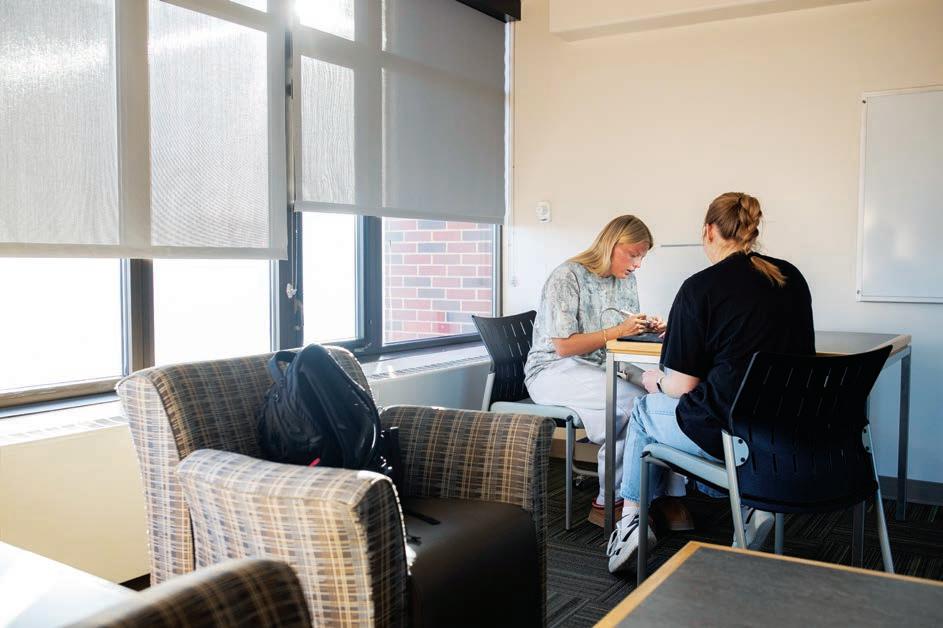
Academy Iowa City, said roughly 375 hours of practice and education are required to obtain a license, which she said is very manageable for anyone interested in the industry.
When nails are applied incorrectly or a client is nicked by a file or drill, there are many different infections or rashes that may result. Lampe said she’s seen infections before that cause clients’ nail beds to become red and inflamed.
She said nail infections can also be painful and feel like there’s bruising under the nails.
She also said tools are typically cleaned with Barbicide after each use to avoid infections.
“There’s all sorts of fungus you can get,” Lampe said. “I’ve seen all sorts of horror stories in the nail groups that I’m in. I’ve seen people’s toenails fall off.”
UI first-year student Emma Woodford said she had her nails done by a peer in a dorm and experienced a lot of pain
after her appointment.
“I thought she did a good job, but when I went to go get my nails done at a real salon, they said that it was a good thing I went to the salon while I did because the way that she put them on, I could have gotten an infection on my nails,” Woodward said.
To avoid safety issues, Lampe said it’s always a good idea to invest in earning a license whether a nail tech wants to be independent or work at an established salon.
“Schooling is always a good idea,” Lampe said. “Not only are you going to learn a lot more, have the proper disinfection protocols — there’s not going to be as much risk. You have that supportive system of being able to ask questions and troubleshoot. I think that’s what school’s for. You get to make your mistakes, and you get to ask questions and have some fun with it.”
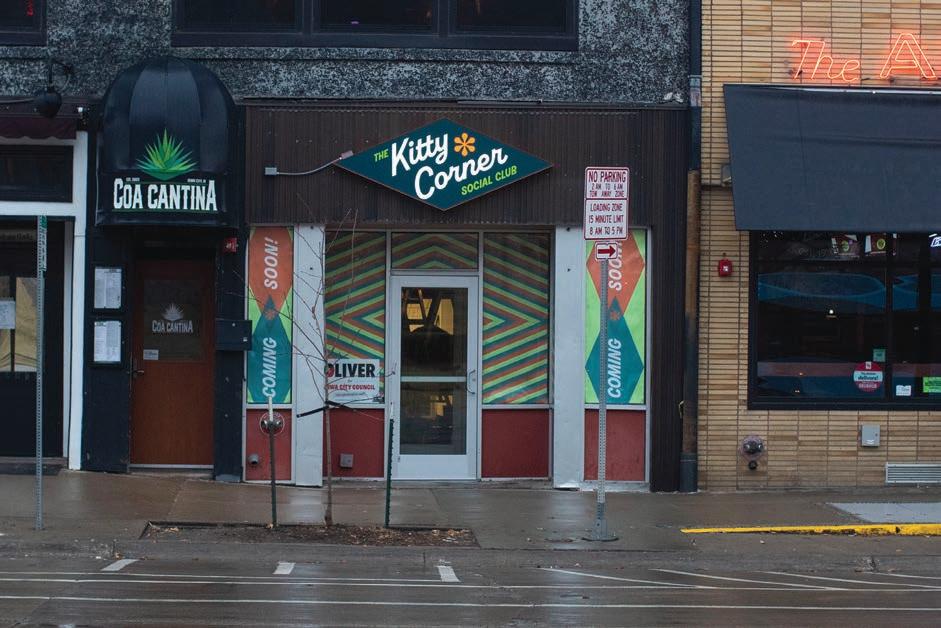
If a visitor wishes to adopt a cat, they will be directed to fill out Kitty Corner’s online application form, which will be similar to what might be encountered at an animal shel- ter. People will also have the option to pre-apply if they are coming from out of town and know they have an interest in adoption.
LOCATION OF KITTY CORNER
The new lounge will sit right off South Clinton Street.
Each cat resident will be fitted with a collar marking them as either female, male, or house cat, which is a cat unavailable for adoption.
“We’re all just here taking care of the cats, welcoming humans, and making sure everyone is safe and well-cared-for.”
Katy Brown Kitty Corner founder
While preparations start to fall into place for the opening weeks, Brown is grateful for the other business owners around her who have been supportive of her efforts with the cat lounge.
“There are great resources available when you dig in, stand up for yourself, and ask questions. Iowa City Downtown District is incredible,” Brown said. “They have provided mentorship, answered questions, and let me know about
funding opportunities.”
Brown hopes to eventually begin hosting community events such as film screenings and cat yoga. She believes these events will help bring an already vibrant and diverse community through the front door.
As the cat lounge has worked on opening its doors, it has also made new job opportunities available for people. Brown describes Kitty Corner workers as “lounge experience specialists” who can work either in the front or back of the house.
Workers in front of the house will be charged with greeting customers, answering questions, and reminding people to take off their shoes, while those in the back will handle the care and keeping of the cats, making sure they are fed and safe.
“We’re all just here taking care of the cats, welcoming humans, and making sure everyone is safe and well-caredfor,” Brown said. The opening date of Kitty Corner remains flexible due to not knowing how quickly the first batch of cats will adapt to their new home. However, the community remains excited for that first day — whenever it comes.
“Animals have a way of just bringing us back to the basics,” Brown said. “In a world full of distractions and things that make us angry, it’s nice just to be present and worry about a little fluff and a purr.”

John Charlson | The Daily Iowan
University of Iowa business major Charlie DeGroot styles a customer’s nails inside of Rienow residence hall on Tuesday, Jan. 28, 2025. DeGroot books her clients via social media.
| The Daily Iowan
Kitty Corner Social Club progresses towards opening on Clinton St. on Wednesday, Feb 5, 2025. The cat lounge is managed by Katy Brown and will open before the end of the year.
OPINIONS
COLUMN
Renovations aren’t enough. We need a new IMU.
The dark hallways, smelly carpets, and disappointing dining options make the IMU a problem.

Opinions Columnist opinions@dailyiowan.com
The Iowa Memorial Union has been a staple of the University of Iowa’s campus since 1923, as the building serves as a physical memorial to all those who have attended the UI and fallen in battle for the sake of our country.
The structure’s original goal was to provide a space for students to study, eat, and gather safely while at college. Despite its rustic charm, in the IMU’s current state, the campus-owned building seems more like a relic of a different era than a consistently welcoming place for people to gather and grow together.
Therefore, I propose that if the university cares about its students, there needs to be a push to build a new union on Iowa’s campus to better help the Hawkeye com-
its current location since 1923 and offers meeting rooms, a food court, and multiple lounge and work spaces for students. It also houses several crucial UI departments including Student Legal Services, Fraternity and Sorority Life, and the Office of the Vice President for Student Life.
The building itself does its job, but every time I step inside, I feel like I’ve been sent back in time as I pass its withering internal walls, long dark hallways, and scary back rooms that lead to nowhere.
A union should be an inviting place where students want to be, not a run-down office space where people are only inside to grab a quick bite and have a meeting for their on-campus club. A new IMU would be a welcome addition to an Iowa campus that needs closer food options and both communal and private study areas.
In 2022, the UI Board of Regents helped to release a 10-year master plan that included renovations to the IMU, and since the design’s approval, we have already seen some improvements to its interior. Recently, there has been the addition of a Starbucks coffee shop in the
More is supposedly coming to the space with the total cost of the complete renovations projected to be around $81 million, with an increase in student fees and outside donations theoretically covering the total amount.
Although the updates to the aging brick behemoth are a welcomed surprise, many students like myself feel it would be better to build a new union instead of making something old and run-down look slightly better with millions of dollars in updates no one asked for.
The UI claims building an entirely new IMU would cost upward of $245 million. While some might gasp at this number, others find the price tag fairly reasonable, seeing as thousands of Hawkeyes use the space every day.
Fourth-year business student Brett Levenhagen echoes this sentiment, claiming the IMU “ just feels so old and decrepit, and the space doesn’t make me want to stay any longer than I have to. A new IMU would benefit everyone, and it seems like a good investment, seeing as the current one lasted over 100 years.”

Conversely, others feel that instead of a new IMU, the upgrades will hopefully fix many of the building’s issues, like its deteriorating interior. The $81 million
budget includes $55 million for deferred maintenance.
Former IMU employee and current Iowa graduate student Ethan Dabareiner is supportive of these updates but hopes the superficial additions don’t overshadow the much-needed internal work.
“As someone who worked in the IMU, most of these upgrades shouldn’t be spent on the fancy new stuff,” Dabareiner said. “It should be spent on upgrading and maintaining the facility as a whole. When I was working there, a sewer pipe burst and spilled. Also, the heater and air conditioning leaked. A lot of the people I worked with said “this building is falling apart.”
Dabareiner said many of his former co-workers are people who do a lot to ensure our university runs smoothly, and they “shouldn’t have to worry about little stuff like this” on the regular.
Regardless of these proposed updates, I remain skeptical about the IMU’s new face-lift.
I feel that if you’re willing to foot the bill for these upgrades, why not go all in on a project that will benefit generations of Hawkeyes?
A new IMU would provide a new and exciting space for all of Iowa’s future generations.
Athletic conference realignment isn’t all bad
Realignment has sent the college athletics world into a frenzy — but in a more positive way than you think.

Jackson Mendoza Opinions Columnist opinions@dailyiowan.com
Old fashion trends should be made new, not brand new
We need to stop spending money on fast fashion and invest in recirculation efforts.

Kennedy Lein Opinions Columnist opinions@dailyiowan.com
Alix Earle just brought back the skinny jean. Whether you like this old trend or not, I say it is both good and bad. Old fashion trends, like skinny jeans, have been making their way back into modern fashion for quite some time now. As they should. Old trends, like baby tees, baggy jeans, knee-high boots, animal print, faux fur, and much more, should always find life again. And there is one place you can find these old fashion pieces authentically — a thrift store. Why are we buying “new” trendy clothes, when second-hand stores carry these items and probably have for years? Every piece of clothing deserves a second, third, and fourth chance, and it is sustainable.
Though Earle seemed to bring back this trend, it wasn’t all her – she campaigned and collaborated with the company Frame. Together they created two pairs of jeans – one pair for $128 and the other $148. This is not only unsustainable when they exist at a second-hand store with probably better quality, but it is also wildly expensive, for what? To prove this, I went to the thrift store myself. One pair of skinny jeans? A measly $5.
When we thrift clothing items instead of investing in overpriced fashion items, it allows them to recirculate into closets. Then, when the trend is no longer, there is no buyer’s remorse for the $148 pair of jeans that you wore for two months and then never again. Sounds like a win-win situation to me.
Purchasing second-chance clothing items is also more beneficial to the environment. Earthday.org mentions harmful dyes and toxic substances are used in clothing production. Producing new clothes admits greenhouse gases, and synthetic fibers, like polyester, come from fossil fuels, making up 70 percent of our clothing. Microfibers are also factored in whenever we wash our new clothing — shedding and making their way into freshwater, the ocean, and the air.
Although it is quite outlandish, the real issue doesn’t necessarily completely lay with Alix Earle’s expensive jeans.The problem is fast fashion. Most people will see Earle’s price for her jeans and turn to their trusty alternative — Shein.
Shein and other fast-fashion industries thrive off cheap retail and old trends that have resurfaced. The Round Up states these textile industries produce 100 billion clothing items a year, adding to 42 million tons of plastic waste per year. Not only that, but 92 million tons of clothing end up in landfills every year. The overproduction from fast fashion causes an excess amount of clothes in donation stores and landfills.
Every piece of clothing deserves a second, third, and fourth chance, and it is sustainable.
There are some simple solutions to this problem, one being a website called Nuuly. Nuuly is just one example of many monthly clothing rental shops where customers can pick out six new items from higher-end brands to interchange in their wardrobe each month. At the end of the month, they pick six new items and send the others back, and they even offer the option to buy some of the pieces. Nuuly also has student discounts for college students. Another solution is to decide whether a thrift store may have this same item before buying new. For example, ask yourself: Would the thrift store have a basic pair of skinny jeans? If the answer is yes, which it is, head to your local second-hand stores to check it out. Not only is it cheaper, but you also don’t have to wait for shipping — And no one likes waiting. Iowa City has tons of local thrift stores at your convenience, including but not limited to Goodwill, Stuff Etc., Crowded Closet, The Salvation Army, and much more. When we as a community can realize purchasing new items at any given time is just adding to the overcrowding of our closets, donation stores, and landfills, then we can finally make a difference in the clothing waste epidemic. Go shop used!
Jami Martin-Trainor | Executive Editor
Columnists: Cole Walker, Muskan Mehta, Abigail Jones, Caden Bell, Reese Thompson, Grace Dabareiner, Julia Anderson, Aaron El-Kadani, Kennedy Lein, Jackson Mendoza
Editorial Board: Jami Martin-Trainor, Marandah Mangra-Dutcher, Jack Moore, Stella Shipman, Muskan Mehta, Charlie Hickman
COLUMNS, CARTOONS, and OTHER OPINIONS CONTENT reflect the opinions of the authors and are not necessarily those of the Editorial Board, The Daily Iowan, or other organizations in which the author may be involved.
EDITORIALS reflect the majority opinion of the DI Editorial Board and not the opinion of the publisher, Student Publications Inc., or the University of Iowa.
On July 1, 2024, the Texas Longhorns and Oklahoma Sooners joined the Southeastern Conference, or SEC, which kickstarted the era of realignment in college athletics.
A month later on Aug. 2, UCLA, USC, Oregon, and Washington joined the Big Ten, expanding the conference from 14 to 18 universities.
This realignment sparked multiple conversations with fans of college athletics. Many people have argued that universities on the West Coast joining the Big Ten have ruined what the conference is all about. Is it peculiar? Sure. Is it a positive change? Absolutely. Conference realignment allows fans to watch more games between high-level programs on a more frequent basis. Who doesn’t want that? In this past college football season, we saw multiple incredible games in the regular season that would never have happened if it weren’t for realignment.
In week two, we saw an incredibly competitive game between No. 11 Texas and No. 3 Alabama. This game was full of lead changes and explosive plays, the kinds of things that make college football so exciting. Texas ended up upsetting Alabama, 34-24, cementing itself as a legitimate contender in the SEC.
In week eight, we watched an instant classic Big Ten matchup between No. 2 Ohio State and No. 3 Oregon. This game was close and finished dramatically as Ohio State quarterback Will Howard slid on the last play with only two seconds left, causing the clock to run out and the Ducks to come out victorious, 32-31. Much like Texas, this win proved Oregon is more than able to compete with classic Big Ten powerhouses like Ohio State.
This game was broadcast during prime time on NBC and averaged 10.2 million viewers while peaking at 13.4 million viewers, according to Sports Illustrated. You cannot deny realignment played a huge factor in these giant ratings.
While Texas and Oregon won these big games against Alabama and Ohio State, these were not their only feats of the season. Both schools played in their respective conference championship game in their first season with the conference. Oregon defeated Penn State, ending the Nittany Lions’ dominant undefeated season as Big Ten champion. Georgia defeated Texas in the SEC championship, proving it is still the big dog of the SEC.
Another great thing about realignment is that it doesn’t just apply to college football; it applies to all sports.
In the women’s college basketball world, Juju Watkins and No. 4 USC visited Iowa on Feb. 2, live on FOX. This game could not have started better for the Hawkeyes, as they were leading, 18-4, after the first quarter. USC did not quit and took the lead, 29-28, entering halftime. The Hawkeyes ended up pulling off the historic upset with a score of 76-69. The celebration did not stop there, as Caitlin Clark’s jersey was retired after the game. This game would not have been possible without realignment.
Realignment gives us as fans more exciting games to watch and the universities more opportunities to gain visibility.
Becoming a member of the two biggest conferences in America sheds more light on these universities, bringing in more admissions and funding. It doesn’t get any better than that. According to Front Office Sports, newly realigned universities can receive up to $21 million from media rights deals. This type of money can completely revamp and improve multiple resources on these college campuses that benefit everybody involved.
As time goes on, be on the lookout for more schools to realign to different conferences and continue to give us fans exciting games to watch.
Iowa child care centers signal need for help
State and local initiatives aim to tackle child care workforce issues in Iowa.

Roxy Ekberg Politics Editor
roxy.ekberg@dailyiowan.com
To supplement low wages in the child care workforce, some employees at Little Clippers Child Development Center in Tiffin, Iowa, work second jobs to make a livable wage.

Stagnating wages, a stressful work environment, and high employee turnover rates have long plagued Iowa’s child care workforce. Johnson County initiatives have alleviated some of the strain, Little Clippers Director Amanda Rairden said, and state legislation signals a larger-scale solution.
A countywide $2 an hour wage enhancement for child care workers allowed Little Clippers to be more selective in its hiring process and dramatically increased employee retention, Rairden said.
Rairden was able to hire five new workers when Little Clippers received the wage boost in 2023 and has retained four since then.
“We had one staff [member] practically cry because $2 an hour during the week is huge,” Rairden said. “$12.50 an hour isn’t livable. Some of them were able to give up a weekend job, which meant a lot.”
Iowa’s hourly average pay for child care workers is $12.62, according to the most recent data from the U.S. Bureau of Statistics. The annual average pay is $26,250.

Child care workers in Johnson County earn an average hourly wage of $12.56, according to Laurie Nash, the county’s youth and family service manager.
Despite the wage improvement, Rairden said there are still changes needed to make the profession more attractive for potential employees.
Iowa Child Care Connect, a website providing real-time information about availability and demand of child care in the state, reports there are 47,858 Iowa children and their families in need of child care as of Feb. 13.
The data shows there are 5,980 child care slots available in Johnson County, yet the demand is 7,884 slots — a deficit of nearly 2,000 children and their families who are not receiving the care they need.
An estimated 23 percent of people in Iowa live in a child care desert, according to the Center for American Progress.
Aiming to address low wages and removing barriers to access child care, local and state initiatives seek to improve Iowa’s ailing child care workforce.
Iowa Gov. Kim Reynolds listed improving the state’s child care industry and voluntary preschool programs as a priority during her Condition of the State Address on Jan. 14. Reynolds announced a plan to launch a statewide program to boost child care worker wages, supplementing an existing network of regional funds which raised over $2.3 million in private investment for 2025. The network, beginning in October 2023, has created nearly 11,000 new child care slots in Iowa, according to a study by the Common Sense Institute of Iowa, a nonpartisan think tank.
Through the governor’s proposed program, businesses and private donors can contribute to a fund that raises wages for child care workers without raising fees for families.
The proposal would allow for direct donations to a specific regional fund through a statewide portal or general donations used to match regional fund dollars.
The governor also introduced a bill to launch a $16 million “continuum of care” grant program for preschool providers and child care centers to partner to provide all-day care for children, using funds to transport children from preschool to day-
care and vice versa. Introduced on Feb. 7, the bill would also offer child care assistance to child care workers and improve preschool quality standards.
“Parents need a solution that meets the demands of their busy lives — one that allows their children to benefit from our successful preschool program and have access to childcare,” Reynolds said in a Feb. 7 news release.
Iowa Senate Democrats have long prioritized improving child care in the state and introduced a legislative package addressing the issue on Feb. 6. The package includes legislation to expand eligibility for state assistance for child care, automatic qualification for child care assistance for parents under the age of 18, and automatic qualification for siblings of children who receive assistance.
The package also includes an initiative to raise child care workers’ wages. However, unlike Reynolds’ proposal, which aims to use donations from public and private organizations, the Iowa Senate Democrats’ proposal plans to double the state’s investment in the Child Care Solutions Fund pilot program. Reynolds seeks to codify the pilot program.
The governor’s proposal will be sent to state lawmakers to review, while the Iowa Senate Democrats’ proposal is likely to be dead on arrival since they are the minority party.
Iowa Senate Minority Leader Janice Weiner, D-Iowa City, said the pilot program injected $3 million of American Rescue Plan Act funds into the state’s child care workforce, and it resulted in the creation of 275 new child care slots in seven communities.

This is similar to Johnson County’s wage enhancement, although research on the program is not finalized, and numbers are not yet known.
“One of the arguments that we’ve made for a long time is that we need to professionalize child care,” Weiner said. “We need to respect those who work in the area because they’re really in the business of helping form young minds in their most formative years, and the wages have been way too low, objectively too low.”
While these state and local programs target the issue, Johnson County child care advocates and experts worry the governor’s legislation may not be enough.
Iowa City experts worry about “one-size-fits-all”
Nash, who has been involved with Johnson County’s child care worker wage enhancement program since it was enacted in 2023, said nine other wage enhancement programs have been launched across the state and all look different.
A statewide wage enhancement program would be beneficial for the industry, Nash said, but she doubts one particular program will be successful throughout the state in both rural and urban counties.
“I think that’s really important to note, as usual, in the state of Iowa, a one-sizefits-all does not work for us,” Nash said.
Nash pointed to Hamilton County — north of Ames in the middle of the state — which enacted a wage enhancement program that was very different from Johnson County’s. She said there are four licensed child care centers in Hamilton County, and the wage enhancement was able to benefit them all. However, in Johnson County with 85 centers, the program had to have criteria to stipulate which centers qualified.
Nash said there is a misunderstanding of how the governor’s initiatives will be funded, as the plan does not allocate any new money to improve child care but rather moves funds from existing sources.
In an email to The Daily Iowan, the governor’s office confirmed the continuum of care grant pilot program will be funded by existing state Early Childhood Iowa funds
as well as funds from the federal Child Care and Development Fund.
Nash said the movement of funds will have local fallout, and it means the county will likely no longer be able to fund Home Ties, a child care center for families experiencing or at risk of housing insecurity. She said the move would also endanger the child care center at the Arc, which serves a number of kids with disabilities.
“I’m hoping that that is not going to be an unintended consequence of this,” Nash said. “I hope we’re not weakening the whole system.”
Liz Ernst, Johnson County’s early childhood coordinator and board member of Early Childhood Iowa, said while the continuum of care program will help alleviate transportation worries for parents, it would take away from the organization’s funding.
Ernst said the shift in funds would take away programs Early Childhood Iowa offers, such as scholarships for child care costs.
Initiatives to expand child care assistance could have adverse effects on Iowa’s child care centers.
Sheila Hansen, senior policy advisor at Common Good Iowa, a nonprofit, nonpartisan organization working to create people-centered policy solutions, said child care providers often lose money when they take on children who are on child care assistance because their reimbursement rates are lower than what a private person might pay the center.
Hansen said a solution to this would be to increase the reimbursement rate centers receive from the Iowa Department of Human Services, which reimburses providers to take children on child care assistance.

There are more issues to address than those outlined in the governor’s proposals, Hansen said, and increasing reimbursement rates would be a good place to start, as well as building up the child care workforce in Iowa.
“There have been lots of funding, lots of money that has gone out for building buildings or increasing capacity, and you can build all the buildings you want and increase the capacity, but if you don’t have the staff to fill those buildings, then it really does no good to spend all that money on increasing the capacity,” Hansen said. “So, we really do need to make sure that the workforce is there.”
Extending local initiatives aimed to alleviate child care worker issues
Johnson County’s child care wage enhancement program will inject $1.5 million into the workforce by the time it ends in 2026.
Michael Chen, Greater Iowa City’s community development program manager, is leading the effort to extend ways to support the local child care workforce.
Part of Chen’s work is speaking with child care providers participating in the wage enhancement and assessing how the program is working for them.

Chen said he’s made his way to at least half of the participating providers, and the general consensus is child care centers recognizing improvement in the ability to retain quality staff and boost morale among child care workers.
Chen and Greater Iowa City are reaching out to local businesses to instill more investment in the child care workforce through business and private donations, similar to how Reynolds proposed to increase child care wages.
“It should be treated as a shared responsibility, in my opinion,” Chen said. “Investing in child care means investing in workforce stability.”
Chen said the governor’s plan to raise wages is sustainable, and not having access to child care prevents Iowans from being in the workforce, which has a negative impact on the economy.
Data obtained by the Iowa Women’s Foundation, a statewide organization that utilizes targeted research to reveal barriers to women’s success, reported that child care issues result in an estimated $935 million loss annually for Iowa’s economy.
“There’s no silver bullet to this, but if we can contribute in a way that helps a greater community and opens up slots, helps employees get to work without having to worry about child care, we’ll be in a better spot,” Chen said.
Megan Ronnenberg, a graduate fellow at the University of Iowa School of Social Work, is leading an evaluation of the county’s wage enhancement program. Ronnenberg surveys participating child care centers at six-month intervals, assessing the impact of the program on a personal and professional level.

She said she is in the middle of her second round of data collection and not yet finished with her research, but her first round of data collection revealed positive results and uncovered struggles for the participating centers.
Ronnenberg said child care workers who received enhanced wages reported being more financially stable as a result, however, they are still facing struggles. In her first survey, Ronnenberg said 80 percent of the workers who responded said they had experienced at least one hardship in the past six months, such as housing insecurity, transportation insecurity, or difficulty affording health care.
“There is some evidence, yes, that the wage enhancement program is helping and working, but it can’t fix everything,” she said. “There still is a lot of support that the child care workforce needs in order to really be well and provide the best quality of care that they can,” she said.
She said Reynolds’ proposals are evidence of a commitment to improve child care and child care outcomes for families in Iowa.
Little Clippers Director Rairden said the “million dollar question” is if these initiatives and programs are enough to address Iowa’s child care workforce’s struggles. Rairden said more can be done to aid the ailing profession, but the state has to start somewhere, and the governor recognizing the problem is a huge step forward.
“I have to believe that it will start taking us in the right direction so that we can offer more centers and slots and fill the gaps for all of these families,” she said.
Child care demand in Iowa
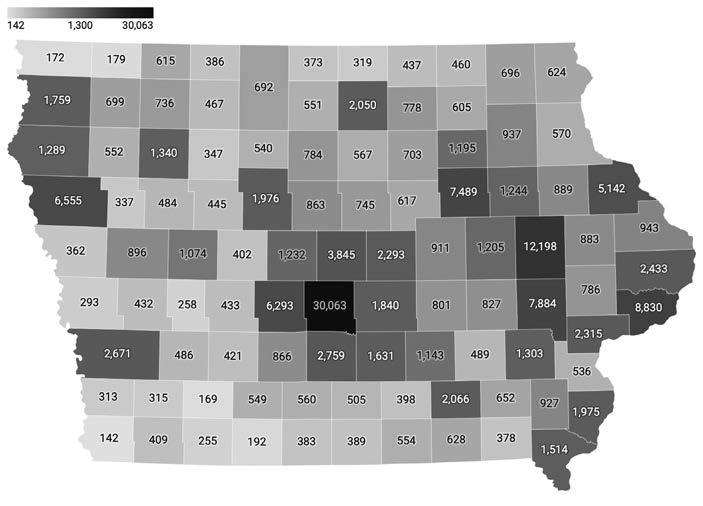
Cody Blissett | The Daily Iowan
Iowa Gov. Kim Reynolds speaks during the Condition of the State address at the Iowa State Capitol in Des Moines on Jan. 14. Reynolds highlighted education, childcare improvements, and government efficiency as some of her top priorities for the 2025 legislative session. Sourced
Ronnenberg
How music is rewriting end-of-life care
Music therapy is growing in hospice care and hospitals, providing pain and anxiety management.
Madison Schuler News Reporter news@dailyiowan.com
Over the years, music has been used to express emotions for some while creating connections and memories for others. Listening to a certain song can take people back to a specific moment. Whether it elicits joy, pain, anger, or sadness, music has a different effect on each individual.
Music stays with people throughout their lives, always bringing forth those emotions or memories.
For those in end-of-life care, music can do the same.
Music therapy has been used for centuries; The American Music Therapy Association states the profession dates back to and formally began in the 20th century.
Music therapists worldwide use various interventions to address health care and educational goals, such as alleviating pain, managing stress and anxiety, improving communication, and more.
Today, hospitals and hospice centers are seeing an increase in the use of music therapy, specifically in end-of-life care.
Katey Kooi, a music therapist of 16 years, supports patients who have serious illnesses or are at the ends of their lives along with families to ease suffering during the endof-life process.
Kooi expressed how beneficial music
therapy can be for end-of-life patients, as it releases dopamine and serotonin neurotransmitters, facilitates emotional processing through discussing lyrics, and supports life review and reflection.
“Music innately is therapeutic because of the way it works in our brain and in our limbic system, so it releases serotonin and dopamine,” Kooi said. “When you hear your favorite song or something from your favorite artist, you initially get that dopamine hit. Then, the therapy portion usually comes in a context of more discussing some of the lyrics.”
Kooi creates personalized playlists — ranging from Beyoncé to John Denver — for each patient to help them through challenging times, such as chemotherapy or radiation. The specific songs allow patients to transcend to a different place, which provides a mental escape from their current situation.
“You can use the lyrics of the song, but also you can do a guided relaxation where I would play guitar in the background and then lead them through kind of a mental script for them to focus on some breathing because you can match the tempo to where their breathing is, and then just bring it down,” Kooi said.
Kooi hopes the use of music therapy will continue to grow.
“Hopefully, [music therapy] can continue
to improve as we show the efficacy of music therapy for patients from NICU aged all the way up to older adults,” Kooi said.

Head of the music therapy area and professor of music therapy at the University of Iowa, Abbey Dvorak, said music therapy uses evidence-based interventions to address various needs, such as motor, emotional, and cognitive goals.
This form of therapy is also practiced in diverse settings, such as mental health facilities, hospitals, schools, rehabilitation centers, and community settings.
“Music therapists use a variety of music experiences, and we use a variety of instruments,” Dvorak said. “The music experiences might be things like composing music together to help express feelings; they might be listening and responding to music in different ways; they might be recreating preferred music of the client — especially if they have positive memories associated with them — and it might also be improvising, where we make up music in the moment, and sometimes that helps us express different things in our lives.”
Dvorak shared the importance of music therapy for end-of-life care patients’ family members as well.
“[Music therapy] can help with connecting with other family members. If we have some songs that the family knows, we can sing those songs and then process and help family members reconnect or connect with the loved one,” Dvorak said. “Doing a life review, talking about important moments that they want to share with their loved ones, also processing some of that anticipatory grief that their loved ones might be experiencing.” Maddison Smith, a recent graduate from the UI, discussed her experience as a new music therapist and how she uses treatment in end-of-life care.
“Your focus is on the patient, but you also are incorporating the support system in any way that you can and trying to learn about their holistic experience with not only their illness, but who they are as a person and what their interests are,” Smith said. Smith echoed how beneficial music is when used to review and reminisce about one’s life. She shared that engaging in that technique can bring people together in the final moments.
“Honestly, that was the part of my internship that I felt was the most impactful,” Smith said. “It was just really beautiful to be in those moments and to kind of provide a glimpse of light or a positive time in a very scary experience.”
AI-enhanced textbooks draw concern from UI professors
University of Iowa students now have access to new AI tools to enhance learning techniques.
Genevieve DiChiara News Reporter news@dailyiowan.com
Recent advancements in artificial intelligence technology are integrating “smart” features into online textbooks, allowing students to interact with the material through personalized explanations, interactive elements, and built-in AI tutors.
Students now have access to new programs to enhance their learning, comprehension, and processing techniques.
The University of Iowa has policies in place about AI; they include having low, medium, and high-risk cases while using AI. The university also has a page located on the UI website giving examples of AI for students and staff to try and learn more about it.
VictoryXR is introducing innovative ways to integrate virtual reality and AI into learning. The company’s platforms allow students to interact in a synchronous yet virtual environment. Educators in the program are given training and 3D objects to teach a variety of subjects to their students.
“But now everybody has an instructor inside their computer, and they can receive this explanation in ways that are just very impressive and very accomplished,” Steve Grubbs, CEO of VictoryXR and UI alum, said.
Grubbs said jobs taught now will be needed drastically less in three to five years. Coding or practicing law are two jobs that will be heavily completed by AI technology, he said.
“That will really send shock waves through the system because you have this entire infrastructure that is set up to teach people how to do things that they will no longer need to know how to do,” Grubbs said.
Grubbs believes the role of the teacher will be redefined but not removed. While technology and new teaching methods will change the role of teachers, they will still be essential.
“If an AI is able to deliver that information and explain it and teach us about that information, then the role of the human teacher will be changed, and humanity still needs its human humanness, so even though an AI may be able to deliver information and teach about that information, it will be a long time before it can do it with humanity,” Grubbs said.
AI is revolutionizing learning, but not everyone is convinced it should be used in classrooms, including Stephanie Haase, a biology professor at the UI.
“[AI] can be used at a point to write questions that you can use to test your knowledge, some of which are better than others, so I think that is a really good potential use for it,” Haase said.
Haase has tried to use CoPilot, an AI-powered assistant available through Microsoft 365 that helps users with tasks like writing, searching, and coding to see what it can do to help with homework. She said it was able to answer a given question but could not show her how to get the answer, which is less conducive to student learning.
Haase doesn’t believe AI can help with engagement

because it often leads to a more passive approach, letting AI handle things and only reviewing the results later. She argues this isn’t as engaging as actually interacting with a real person.
While she doesn’t believe AI can help with engagement, both Haase and Grubbs believe that AI is great for helping people who want to translate a piece of text or lecture into the language most valuable to them.
Haase added that AI is an excellent tool for students who take notes online. Students can put their notes into the program and and receive questions posed to help them process or even go more in-depth in areas where they may be confused. With essays, AI can check places where the writing is lacking and where it should be evaluated.
Kylah Hedding, a journalism professor at the UI, said students need to learn how to use AI correctly rather than using it to skip steps or cheat in class.
“It’s not going away, and we can’t remove it, so we need to figure out how best to incorporate it,” Hedding said.
Hedding agreed that AI tools can be positive for study aids or learning definitions.
“[AI] can be super useful when you know where the problem is, but you need to learn some of the basics of things before the AI is going to be actually super useful for you in terms of writing and developing arguments, where you can recognize where the AI is hallucinating incorrect information,” Hedding said.
Hedding said when she told her students to edit the writing that AI had created, they all realized that what it had generated wasn’t good, and the students’ work was much better.
Hedding said she does not believe AI will encourage critical thinking at all. In fact, she believes it will do the exact opposite.
Grubbs disagrees and believes it will give people an advantage and another opportunity for responses and increasing education options.
“One of the great things about AI is that it can ask you questions, [it can] listen to your answer, and then tell you if you got it right, if you were close, and provide feedback,” Grubbs said.
Rather than just memorizing or using AI to generate an answer and move on, VictoryXR has created a product where students can debate AI on a particular topic to become more knowledgeable.
Although there are a lot of pros to AI having these advantages, there are still problems that may arise.
“There’s a lot of ways that AI will contribute to critical thinking, but at the same time, sort of like the invention of the garage door opener, nobody has to get out of their car anymore and go lift up the garage door. And so nobody does, even though it might be healthier,” Grubbs said.
Grubbs believes AI tutors and textbook advancements are unlocking a big future.
“A lot more is on the horizon,” Grubbs said.

Logan McCaw | The Daily Iowan
Photo illustration of textbooks along with artificial intelligence tools.
Dvorak
UI Diabetes Link searches for community support
The number of people with Type 1 diabetes is expected to triple by 2060.
Jack Moore Managing News Editor jack.moore@dailyiowan.com
More than 7,500 students with Type 1 diabetes enter college every year, and the number is only growing. At the University of Iowa, a student organization called Diabetes Link is working to support students with the disease, but they say it’s become harder to build that community.
“I think there’s more people [with diabetes], but I think the communities have lost numbers, especially because of COVID,” Sophia Karthik, secretary at Diabetes Link, said. “I think COVID separated us from our communities, and no one really went back to them after the fact, and so [Diabetes Link] is trying to rebuild that connection.”
Type 1 diabetes is an autoimmune disorder that impacts more than 2 million people across the U.S. The disease develops when a person’s immune system attacks certain cells in their pancreas, making it impossible for them to digest energy from carbohydrates without artificial insulin.
Unlike Type 2 diabetes, Type 1 diabetes is genetic, and it’s increasing in young people for reasons scientists have not yet identified.
Naina Miranda, vice president of Diabetes Link, said the disease requires constant management. She said having a constantly changing routine in college is just one of the challenges college students with Type 1 diabetes face.
People with Type 1 diabetes must give themselves insulin before every meal containing carbohydrates. Most people have
three meals a day, but if that schedule shifts, it could impact that person’s health. If it’s not managed well, it could lead to further health complications or, in extreme cases, death.
The burden Type 1 diabetics face is softened, she said, by organizations like Diabetes Link through its ability to create community. Organizations like Diabetes Link are spreading to campuses across the country.
The College Diabetes Network, which created Diabetes Link at Iowa, has grown to over 20 chapters.
The closest chapter to the UI is at the University of Wisconsin, and the farthest reaches the University of San Diego.
Despite these organizations, Miranda said many people with Type 1 diabetes don’t seek out other people.
Palin Narsian is the treasurer for Diabetes Link and said the transition to college as a Type 1 diabetic was challenging, and finding his community greatly impacted his experience at the UI.
“The main thing is just realizing that you’re not alone, and you’re not dealing with it by yourself because a lot of times in your day-to-day life, you’re not gonna meet people with diabetes. A lot of people don’t understand the consequences of it and just how prevalent it is in our lives,” Narsian said.
People with Type 1 diabetes face many challenges, including increased doctor visits, constant blood sugar management, and obtaining increasingly expensive insulin.
The annual insulin price from 2014
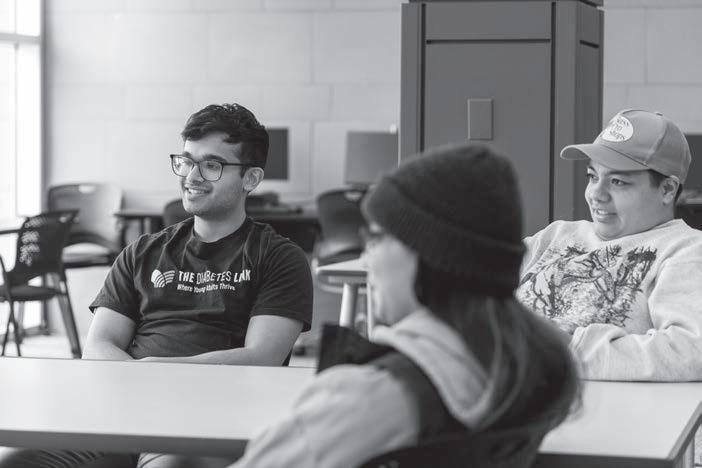
to 2019 rose from $3,819 to $5,917 for a month’s worth of insulin for individuals without insurance. Since 2019, there have been efforts to cap the price of insulin at $30, but that is only a solution for access if insulin is in stock.
Karthik said she needed to borrow insulin from Miranda last year because there was a nationwide shortage of the drug. Insulin shortages and high prices have caused millions to ration their own medication, which is not only unhealthy but can eventually lead to a Type 1 diabetic’s death.
At least five people died in 2019 from insulin rationing, though that number is likely much greater because insulin rationing deaths are seldom reported.
Karthik said getting appointments for insulin refills is vital, and she said the wait time to meet with her endocrinologist at UI Health Care has increased to a year, which makes getting those refills harder.
“Right now, it’s a very long wait. I’m not really used to it. Usually, there is a long wait. Generally everywhere else, like the Des Moines area, it’s usually like six months, but
this is double that,” Karthik said. All three Diabetes Link members said having someone to talk to about their disease is what makes their organization meaningful.
Miranda said the group hosts informal events to get people in the same room together and bond over their shared experiences. She said their most recent event was pumpkin painting, but it has been hard to get many people on campus to attend. She said she hopes people with the disease will come to find community in the future because while living with Type 1 diabetes is challenging, it is easier when there are people around for support.
“Coming to college, it’s like everything’s reset,” Narsian said. “With the Diabetes Link, you have people that have gone through a couple years in college, you know you’re not completely alone, so it helps you build that support system again.”
The organization is planning their next event involving a speaker from Camp Hertko Hollow, which is specifically for children with Type 1 diabetes, on Feb. 18.
UIHC workers present contract demands to Iowa regents
Members of the UIHC union pushed for higher wages, better benefits, and improved working conditions.
Emma Jane News Reporter news@dailyiowan.com
Members of the University of Iowa Health Care workers union met with the Iowa Board of Regents bargaining team to begin negotiations for their 2025-27 contract. The UIHC chapter of the Service Employees International Union, or SEIU, Healthcare Minnesota demanded wage increases along with more benefits.
Meeting at the UI Pomerantz Family Pavilion, union workers called for a 14 percent wage increase, followed by 12 percent the next year, and more paid time off for illness and bereavement, improved working conditions, and other benefits. The board of regents’ bargaining team counteed with a proposal for a 3 percent wage increase and did not address the workers’ other demands during the first collective bargaining session on Friday, Feb. 14.
Emotions ran high as UIHC workers reached the portion of their presentation addressing the need for more time off for illness, injury, vacation, and bereavement. Linda Bramer, a social work specialist, fought back tears as she recounted taking time off last year to care for her son after he attempted to kill himself.
“That was one of the hardest times of my life,” Bramer said. “But I’m constantly worried about when I come back, what am I going to face?”
In addition to proposing changes to the sick time policy, the union also demanded workers receive 10 days of leave following the death of a close family member. Currently, they are allowed only three days, which nurse Kelsey DeWeese called insufficient, arguing it ultimately would not benefit patients.
“Three days is not adequate to even plan a funeral, let alone be prepared to come back and take care of patients that are potentially dying,” DeWeese said.
The union also called for increased differentials — additional hourly compensation — for employees working overnight shifts, serving as charge nurses overseeing their colleagues, and training new staff, among other responsibilities. Workers argued the current differentials fail to incentivize employees to take on these less desirable roles, contributing to ongoing staffing shortages at the hospital.

“We’re here for the reputation the university has shown people, and all we’re asking is to be compensated appropriately for what you’re asking us to do,” DeWeese said.
Additionally, several union members reported taking significant pay cuts to work at UIHC. Gabrielle Schneiderman said she took a $20,000 pay cut compared to her previous job, underscoring the need for wage increases.
“Every two years, we have to fight tooth and nail for the minimum raise,” Schneiderman said. “That’s not enough to keep up with market standards.”
In addition to wages the union said fall below average health care salaries in other Midwestern states, physician’s assistant Michele Whaylen, who reported taking a $40,000 pay cut compared to her previous job, highlighted the additional financial hardships UIHC workers face due to their employment.
“There’s the nickel and dime-ing with the parking, the increased cost in the cafeteria, increased cost of holding certifications,” Whaylen said. “That just doesn’t help.”
After the union concluded its presentation, Michael Galloway, chief negotiator for the board of regents, said the bargaining procss is limited due to state law passed in 2017 restricting negotiations to base wages, excluding benefits, leave policies, and other workplace conditions.
He also claimed that UIHC staff turnover has decreased 4 percent from last year and that UIHC has spent $30 million over the past 18 months, benefiting 3,600 union employees. A member of the union pointed out that this $30 million is less than 1 percent of UIHC’s $5.34 billion budget, but Galloway claimed that $30 million is still “a lot.”
“Nobody on this side of the table, and I hate to use that term because it should be collaborative, thinks you are not dealing with the hardest patients in the state,” Galloway said. “We understand that.”
While commending the union for their work, Galloway presented the board’s counteroffer of a 3 percent wage increase for each year of the two-year contract. The board of regents bargaining team then left the room as the workers’ union began its private session.
During the union’s presentation, several community members — many holding signs with supportive messages — attended,



including Iowa City City Council candidate Oliver Weilein and Johnson County Supervisors Rod Sullivan and Mandi Remington. Remington, who held a sign reading,
“Healthcare workers deserve real raises,” said the union’s demands resonate with her personally, as she worked as a medical records clerk and guardianship specialist at UIHC for 18 years.
“After 18 years, I had to leave because I couldn’t make a living wage,” Remington said. She said it is shameful UIHC workers are not properly compensated, emphasizing they are the ones doing the daily heavy lifting to uphold the reputation of UIHC and the UI, which she called the foundation of the Iowa City community. Remington also said she has personally known many hospital staff who have suffered due to deci-
sions made by the board of regents.
“They have put up with a lot for very little,” Remington said.
The contract was not finalized during Friday’s bargaining session, but Chris Russell, the union’s internal organizer, indicated the proposed 3 percent increase was not adequate. The Union said negotiations will continue until March, at which time the contract must be ratified.
In an email statement to The Daily Iowan, Josh Lehman, senior communications director for the Iowa Board of Regents, emphasized this was only the first collective bargaining session.
“The board and the University of Iowa value the members of SEIU,” Lehman wrote. “The parties exchanged opening offers, and negotiations will now continue in accordance with Iowa law.”
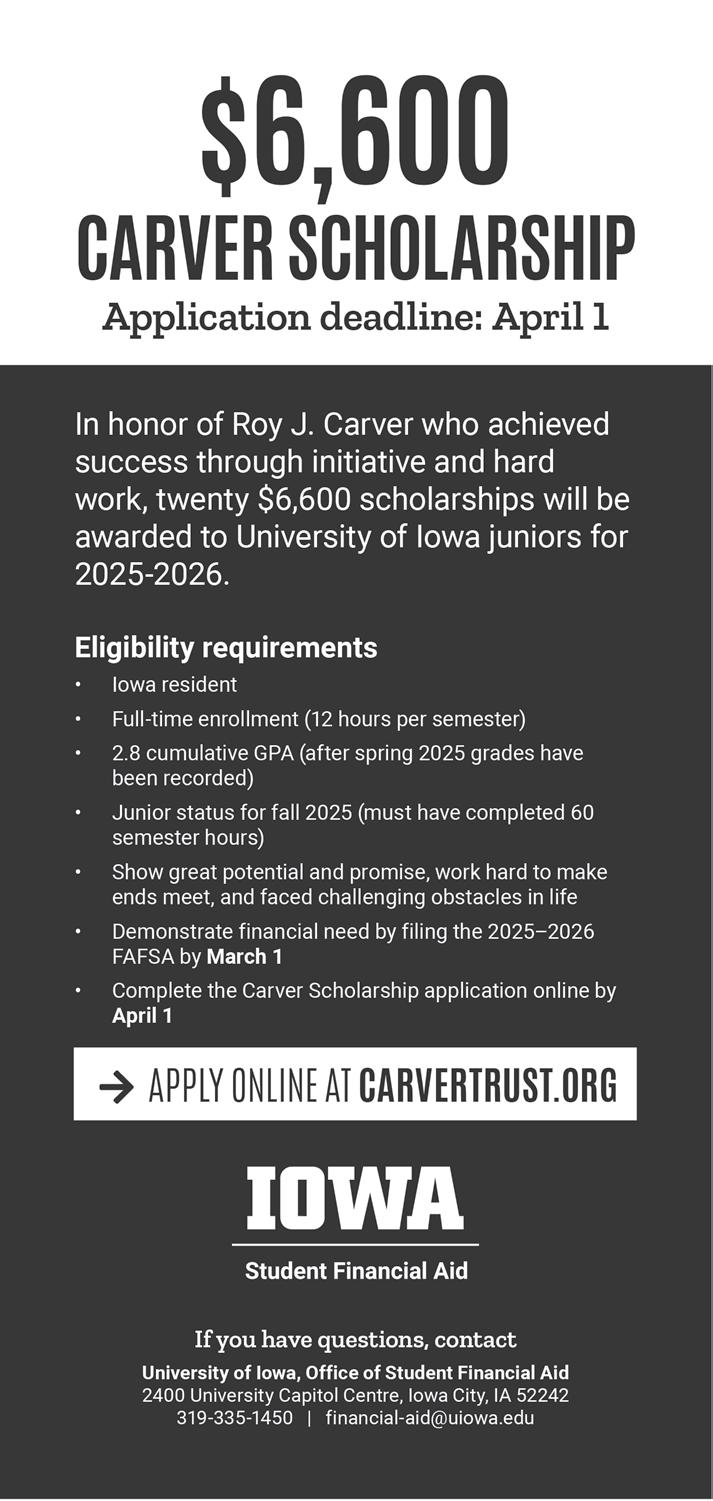
Wyatt Goodale | The Daily Iowan
Palin Narsian (left), Naina Miranda (middle), and Sophia Karthik (right) of the Diabetes Link program sit during an interview with The Daily Iowan in Iowa City on Feb. 11 The program offers support and advocacy for those with Type 1 diabetes.
IOWA CITY SNOWDAY
Over 100 students gathered on The Pentacrest last week to participate in winter activities.
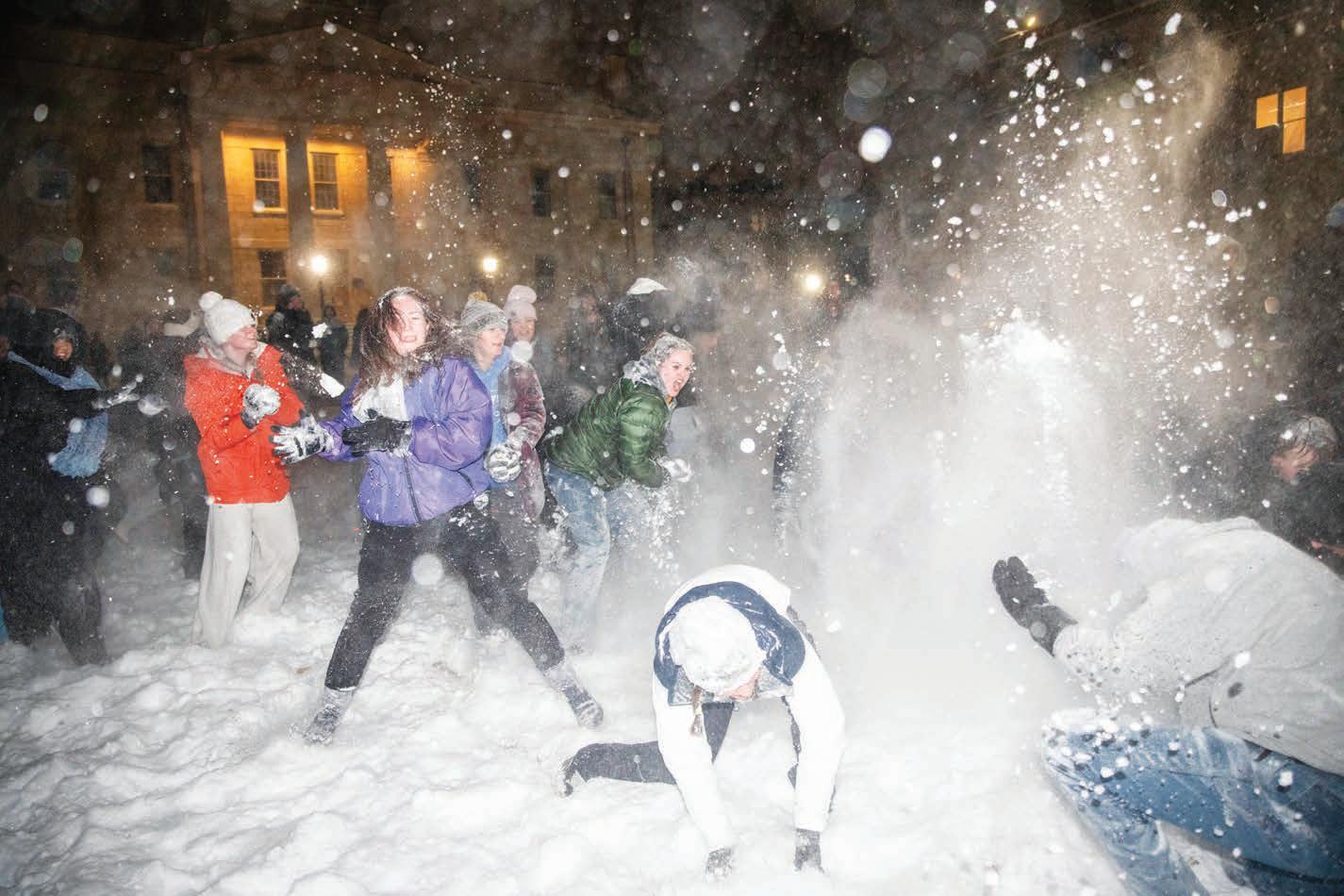
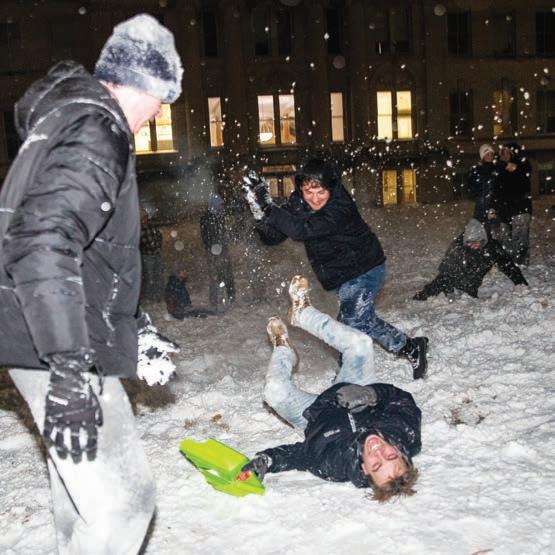

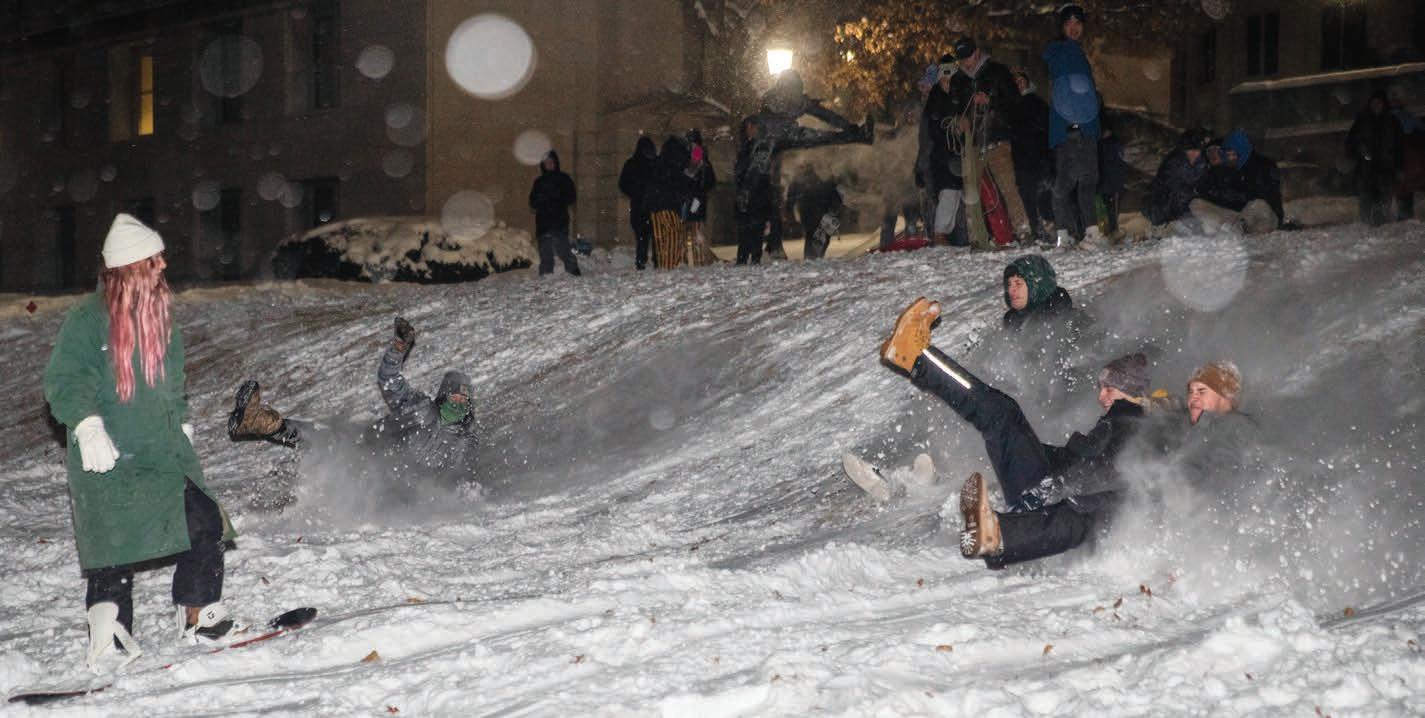
DI Staff | The Daily Iowan
(Top) Students throw snow during a snowstorm in Iowa City on Feb. 12. Hundreds of students gathered on the Pentacrest throughout the evening. (Left) Students throw snow during a snowstorm in Iowa City. Multiple professors canceled class that day because of the weather.
(Right) A student snowboards during a snowstorm in Iowa City. Iowa City reported an expected six to nine inches of snow. (Above) Students sled during a snowstorm in Iowa City. Sub-zero temperatures persisted throughout the week. (Beside) Students pose for a portrait during a snowstorm in Iowa City. Multiple weather advisories have been issued the past couple of weeks, but temperatures are projected to reach above 50 degrees next week.
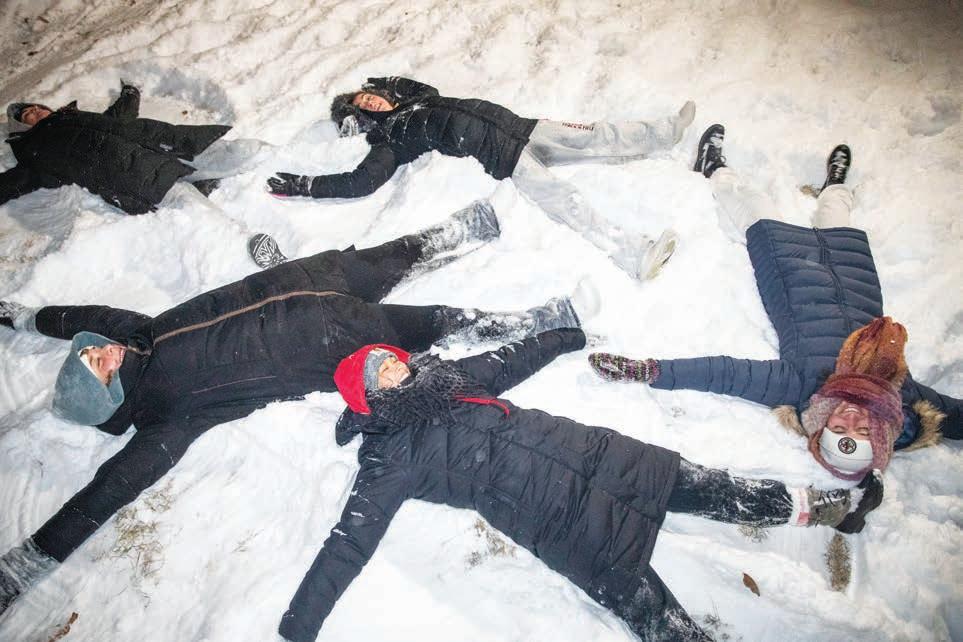
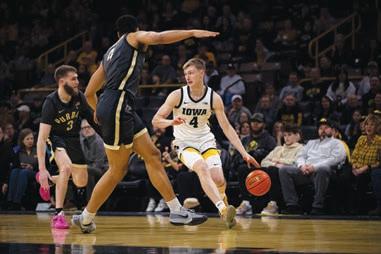
THE HOUSE SETTLEMENT
Iowa women’s wrestling adapting to change
Clarissa Chun discussed the settlement’s possible impact with The Daily Iowan

Iowa head coach Clarissa Chun answers questions from the media during Iowa women’s wrestling media day at the
the Iowa women’s wrestling program isn’t going anywhere, it will still be impacted by the House settlement.
Colin Votzmeyer Sports Editor colin.votzmeyer@dailyiowan.com
While the House settlement threatens to uproot smaller sports across the NCAA, Iowa women’s wrestling isn’t going anywhere — but that doesn’t mean it won’t be impacted. The House settlement, named after plaintiff and former Arizona State swimmer Grant House, has become the collective name for a handful of attor -
neys settling their lawsuits against the NCAA regarding compensating players for their play.
The settlement, pending final approval on April 7, will have three big impacts. First, it will force the NCAA to pay former Division I athletes in backpay. Schools will then have the option to opt into directly paying their current players through shares of revenue the university’s sports bring in, and the NCAA can directly limit schools’ name, image, and likeness funds to recruit athletes.
It will also eliminate scholarship limits, so universities can offer a scholarship for each roster spot, but rosters are now limited as a result. Some athletes will be cut from their current teams, and even fewer will be recruited to join moving forward. While much of the concern has centered around cash cows in football and basketball as well as Title IX implication, small sports will be dealt a great blow, too. Their coaches and the managers and athletic directors above them will be suddenly forced to navigate a testing landscape of
Iowa softball’s ‘Big Three’ aim to live up to hype in 2025
Soo-Jin Berry, Jena Young, and Jalen Adams were all added to the Big Ten Players to Watch list.



on the softball field, and Adams said she is beyond thrilled to share the field with her co-stars who have made substantial marks on the team.
“I think having two of our middle infielders on that list is a huge deal,” Adams said. “Because they make such a big impact on our defense, and I’m really proud of them.”
One week into the new season, the Hawkeyes’ big three look to prove why they were added to
watch list: their crucial contributions to the game. Last season Berry started 36 games for the Hawkeyes, posting a .322 average with a team-leading 26 runs batted in. Berry pushes herself to maintain her success as she BIG TEN
decisions and funding. And with the addition of women’s wrestling to the University of Iowa athletics program just two years ago, question marks suddenly surround head coach Clarissa Chun’s team.
UI Director of Athletics Beth Goetz discussed revenue sharing with the Presidential Committee on Athletics earlier this month but did not divulge what sports receive what percentage of said revenue.
WOMEN’S BASKETBALL
Winning streak keeps postseason hopes alive
Following a dismal five-game skid, the 2024-25 season has been given a breath of life.
Chris Meglio Sports Reporter sports@dailyiowan.com
Talk about an instant turnaround.
After suffering a five-game losing streak in mid-January, their longest since 2013, the Iowa women’s basketball team responded with six straight wins, including a massive upset victory over No. 4 USC on Feb. 2.
The losing woes caused many fans to lose all hope for an NCAA tournament bid, but the Hawkeyes have completely flipped that around and are right back in the mix for a postseason spot.
While head coach Jan Jensen has admitted there were “tweaks” with the rotations and gameplans, she said they were “nothing wholesale.”

“We’ve tweaked a few things offensively,” Jensen added. “Defense has kind of been our calling card. I think [it is] what has really served us well.”
Iowa’s rotation consists of a veteran starting lineup and a young bench — an imbalance of experience. The Hawkeyes saw great success earlier in the season, but hitting that mid-season roadblock, especially in a very competitive conference, was bound to happen.
All teams go through adversity during a long college basketball season, but it’s the great teams that adjust and persevere through the tough times. As the calendar nears March, Iowa appears to be hitting its stride at the right time.
“By February, you really want to be trying to play your best basketball,” Jensen said. “So, I think it’s comfortability, that synergy, and I think it just takes a little longer. And the younger you are, it’s going to take longer.”
While the Hawkeyes’ underclassmen have upped their production during the winning streak, the veterans have also woken up from their slumber. The most notable example of this has been the play of fourth-year guard Lucy Olsen, who looks to have regained her old. Olsen’s numbers took a dip during the five-game skid, averaging only 12.2 points, 4.2 assists, and 3.4 rebounds per game on 32 percent shooting from the floor. She was held under 20 points in all six contests, including two single-digit scoring nights.
Since then, the senior has turned a massive corner,
Ethan McLaughlin | The Daily Iowan
Iowa infielder Jena Young flexes toward the dugout during the second of two softball games between Iowa and Michigan State at Bob Pearl Field on March 30, 2024. The Hawkeyes defeated the Spartans, 1-0.
Men’s Basketball
Wednesday, Feb. 19
Oregon Iowa City, Iowa
7:30 p.m.
Saturday, Feb. 22
Washington Iowa City, Iowa 3 p.m.
Gabe Arnold willing to do whatever it takes
Despite previous success at 174 pounds, Iowa men’s wrestler Gabe Arnold has offered strong production in the 184-pound weight class for the No. 3 Hawkeyes this season.
Trey Benson Sports Reporter sports@dailyiowan.com
Moments before the highly anticipated match between Iowa’s unranked first-year phe nom Angelo Ferrari and Penn State’s No. 1 Carter Starocci in the famed Bryce Jordan Center was set to take place, one mem ber of the Iowa men’s wrestling bench couldn’t bring himself to watch.
Men’s Wrestling
Sunday, Feb. 23
Oklahoma State Iowa City, Iowa
7:30 p.m.
Women’s Wrestling
Saturday, Feb. 22
NCWWC Region VII
Championships Indianola, Iowa
10 a.m.
Gymnastics
Friday, Feb. 21
Track and Field
Friday, Feb. 21
Matador Qualifier
Lubbock, Texas
Friday, Feb. 21
Arkansas Qualifier
Fayetteville, Arkansas
Friday, Feb. 21
Iowa Open Iowa City, Iowa
11 a.m.
WHAT YOU’VE MISSED
Former Iowa women’s basketball player Ava Jones has been diagnosed with Hodgkin’s lymphoma, a type of cancer, per an announcement on her Instagram page. According to Yale Medicine, the disease is treatable with 90 percent of the people diagnosed at an early stage expected to recover.
The diagnosis is another devastating setback for Jones, who was forced to medically retire from basketball prior to the 2024-25 season due to injuries sustained in a 2022 car accident that claimed the life of her father, Trey, and severely injured her mother, Amy. The driver, who prosecutors said was high on fentanyl, was later found guilty of murder and two counts of assault.
Though she is no longer on the team, the Hawkeyes have kept Jones on scholarship and are ready to offer their full support to Jones and her family.
“While this news is so hard to believe, there’s no question that Ava will fight like she has so courageously in every realm,” Iowa head coach Jan Jensen said in a statement.
“In our first conversation, she told me she is going to kick it. And that’s an attitude that has always served her well.”
QUOTE OF THE WEEK
“There’s times in your career where you’re just really proud of your team. It’s how you respond.”
— Iowa men’s basketball head coach Fran McCaffery, after an 8473 win over Rutgers on Feb. 12
STAT OF THE WEEK
Iowa women’s basketball wins six games after five straight losses
With emotions running high in the sold-out Penn State crowd, fellow 184-pound wrestler Gabe Arnold was visibly upset on the Iowa bench prior to the start of the match.
Arnold’s disappointment over not getting the opportunity to face Starocci ultimately led head coach Tom Brands to escort Arnold back to the locker room.
His exit was not due to sheer excitement but instead resulted from agonizing frustration.
Arnold was seen talking to assistant coach Terry Brands seconds before the start of the eighth bout. Arnold was later seen walking out of the arena alongside Brands with his head down, begging for an opportunity to prove himself. The decision to start Ferrari was by no means Arnold’s, as he made it clear to the public that he wanted the chance to grapple with the veteran Starocci.

ing the decision behind giving Ferrari the start.
“We didn’t get the job done last year, and that sucks, but we’re going to get it done this year,” Arnold said of Penn State after a win over Ohio State on Jan. 25. “So this time, we’ll be in your home dojo. And I promise, your head’s mine.”
Arnold’s confidence and mentality are just some of the many attributes that made him such a sought-after 174-pound recruit coming out of high school. But at the end of the day, head coach Tom Brands trumps all decisions regarding the starting lineup.
Following the 30-8 loss to Penn State, Tom immediately spoke to the media to squash any predetermined rumours regard -
Q&A | BLAKE GUERIN
“We’ve got to load manage Gabe Arnold. That’s a term in the NBA that people don’t like,” Tom said. “Gabe Arnold, we need to make sure that he’s feeling pretty doggone good. He’s our guy at 184.”
This is not the first time Arnold has had to step aside in a crucial match this season, as Ferrari also got the start against in-state rival Iowa State on Nov. 23. Ferrari was successful in his first match as a Hawkeye, recording an 8-2 win over No. 15 Evan Bockman.
Following the disappointment of not wrestling Starocci, Arnold could have easily let the emotions get the best of him and dictate the rest of his matches this season.
The red-shirt first-year Hawkeye quickly proved doubters wrong just two days later in Iowa’s dual meet against No. 25 Maryland. Arnold defeated No. 11 ranked Jaxon Smith in a narrow 2-1 decision that went into tiebreakers.
The maturity displayed from the freshman showed even the most pessimistic wrestling fans he is a force to be reckoned with at 184 despite previously being known for his prowess at 174 pounds in high school.
Now 12-2 on the season with his only losses coming against No. 8 Silas Allred in a sudden victory and a medical forfeit to teammate Angelo Ferrari in the Soldier Salute, Arnold’s teammate-centered attitude could be
Iowa baseball first baseman talks favorites
Jackson Miller Sports Reporter sports@dailyiowan.com
The Daily Iowan : Who is your baseball idol or role model, and why?
Blake Guerin: Growing up, it was Derek Jeter. I always watched him and tried to model my game after him. Then, it became Miggy [Miguel Cabrera] in the last few years.
What is the better baseball sound: the pop of the glove or the crack of the bat?
The crack of a wood bat, I can’t lie. That’s probably my favorite.
What is the biggest hot take you have about food?
I’m a big food guy. I love food. My biggest hot take is that pineapple belongs on pizza.
crucial for the No. 3 Hawkeyes as the postseason inches closer. He’s always promoting his teammates, but he’s got the threat in his own matches, too, as he continues to progress under Brands’ leadership.
“I like putting points on the scoreboard,” Arnold said. “That’s my goal every time I step up on the mat, is to make that scoreboard look real lopsided one way and throw football scores on my side.”
With Ferrari’s potential at 184 pounds, Arnold could spend next year filling the void at 174 pounds as a powerful one-two punch in Brands’ back-end of the lineup.

Are you a cat person or a dog person? Dogs, 100 percent. I’m not afraid of many things, but I’m not the biggest fan of cats, but I absolutely love dogs.
What’s your favorite place you’ve traveled to? Costa Rica — Costa Rica is pretty sweet. We went on a family trip.
What made you want to come to Iowa?
The coaching staff — I liked how welcoming they were and how honest and straight-up they were. That was everything I could ask for in a coaching staff.
What is your go-to restaurant in Iowa City?
Estela’s. I’m a big fan of Estela’s. [It has] great Mexican food, and all the guys go grab it before or after practice.
What is your pregame routine?
Nothing crazy. It’s usually the same every day. I just make sure to get some swings in and stay loose with the guys. A big part for me is to take my mind off of the game and hang with the boys.
Do you have any baseball superstitions that you like to follow?
I just don’t step on the white line and always shake the first base umpire’s hand before the first pitch. Those are two things I always do.
Who is their most important recruit to target?

Kate Harpring
Iowa women’s basketball has developed into a program that can go after some of the top recruits in each class and have a legitimate shot at landing them.
The success of Caitlin Clark and the developments of Kate Martin, Megan Gustafson, and Monika Czinano — combined with the atmosphere of home games and support from the fanbase — make the Hawkeyes a desirable location for young prospects to develop their game.
With that in mind, Kate Harpring, the No. 2 ranked player in the class of 2026 by ESPN, took her official visit the weekend of Feb. 2 and got to watch unranked Iowa take down No. 4 USC and Juju Watkins, followed by Clark’s jersey retirement.
Harpring, the daughter of 11-year NBA veteran Matt Harpring, is a 5-foot-10 combo guard from Atlanta, Georgia, who currently holds offers from UConn, LSU, and South Carolina along
with Iowa. She is currently a junior attending Marist High School.
She averaged 27.8 points, 8.3 rebounds, 4.7 steals, and 4.3 assists per game on 58 percent shooting for the 2023-24 high school season and was named MVP of the inaugural Overtime Select tournament — proving she’s got next-up potential to suc ceed Clark. Such performances shot her up the rankings to where she sits only behind Saniyah Hall of Montverde Academy in Florida. If Harpring commits to Iowa, she would join a core of current Hawkeyes in Aaliyah Guyton, Taylor Stremlow, Ava Heiden, and Teagan Mallegni — each working cohesively as a team and more than capable of building a threat under Harpring’s scoring. That’s not to mention 2025 incoming recruits Addie Deal and Journey Houston, who should stay with the program by 2026. Not only that, but shev would be the biggest recruit committing to Iowa out of high school in the school’s history for both men’s and women’s hoops. It is and will continue to be a dog fight for any program to land Harpring until the day she publicly makes a decision, but if Clark is any proof, the Hawkeyes need to land one just like her to succeed.
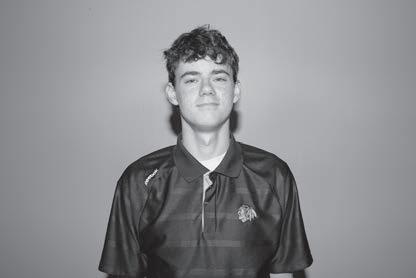
Iowa will be graduating a lot of size in the next few seasons, meaning 6-foot-2 Addison Bjorn, a 2026 wing, is a musthave.
This season, the Hawkeyes have collected high figures in regular contests, and a big part of this success comes from their size in the paint, namely fourth-year Addison O’Grady, third-year Hannah Stuelke, and first-year Ava Heiden.
Of course, one can only stay with the program for so long, and by the time the class of 2026 takes the court, both O’Grady and Stuelke will have moved on from the Iowa program. A 6-foot-4 Heiden and 6-foot-1 first-year Teagan Mallegni will be the Hawkeyes’ main weapons in terms of size. As both Heiden and Mallegni will likely be in their third year of eligibility by that point, Bjorn is a necessity for the program. Officially listed as a small forward by
247 Sports, the Missouri native also showcases position versatility.
“Bjorn is a capable guard, wing, or even forward, depending on her matchup,” Brandon Clay wrote for 247Sports. “That’s a rare quality for a player who stands 6-foot-2.” Outside of stature, the wing’s performances speak for themselves. Bjorn is currently ranked by the same website as 2026’s No. 1 recruit in Missouri, the No. 3 small forward, and No. 11 nationally. The forward is also a two-time gold medalist for USA Basketball, winning accolades at both the 2024 FIBA U17 World Cup and 2023 FIBA U16 Americas Championship.
In an article by Sportskeeda’s Rey Alcaraz, Bjorn was revealed to have drilled in her first career dunk in a game on Feb. 5, a moment the cameras unfortunately missed.
“In-game dunks remain a rarity outside the college and professional ranks,” Alcaraz said in the article. “Bjorn’s ability to elevate above the rim makes her one of the most exciting young prospects in the sport.”
The next few seasons will see Iowa graduating a lot of talent in terms of size. It’s for this reason that 2026’s Addison Bjorn is a must-get.
Blake Guerin First baseman
Ayrton Breckenridge | The Daily Iowan
Iowa’s 174-pound Gabe Arnold walks onto the mat during a men’s wrestling dual between No. 3 Iowa and No. 16
Oregon State at Carver-Hawkeye Arena on, Nov. 19, 2023. Arnold, a true freshman, made his Carver debut. The Hawkeyes defeated the Beavers, 25-11.
Jack Birmingham
Chris Meglio Sports Reporter

“You’re going to see here at Iowa and across the country that people will be more thoughtful about projects that aren’t necessities in the moment and that don’t help you drive revenue,” Goetz said. “To be candid, we wish this wasn’t the moment in time that we needed to focus on [upgrades to Carver-Hawkeye Arena] as well. But this building is a revenue-generator.”
While not quite a project Goetz was referring to, women’s wrestling doesn’t generate a lot of money relative to football, basketball, or even men’s wrestling at Iowa. Iowa women’s wrestling is projected to make $80,000 in fiscal 2025, whereas Iowa men’s wrestling is projected to make over $1 million.
But with the spearheading effort of a Power Four school establishing such a program, it’d be worse to chop it right at the smell of blood. So, as costly as it is to establish another sport alone at the university, the House settlement now makes it difficult to maintain.
That’s amid pressure for the athletics program to properly fund its money-making sports like football and basketball first. It will need to keep as much of its own revenue as possible to recoup the costs of recent expenses such as the brandnew Goschke Family Wrestling Training Center. And it will the need the money to afford a facelift to Carver-Hawkeye Arena where the Hawkeyes wrestle their home meets — to which Goetz has already committed and began.
With the wealth of success the Hawkeyes have seen in the collegiate wrestling sphere — a historic program earning Iowa City the nickname “Wrestletown, USA” — a women’s wrestling program made sense. But that was announced four years ago. No major Division I program has followed suit, and it’s hard to imagine one will now with resources even tighter to establish one.
So, the newest sport to join the UI stoked fears in Chun that it would be the first to leave. But the university assured her that wouldn’t happen.
“I think the University of Iowa is really great and supportive of women in athletics, and they have no plans of dismissing our program, which I’m really
BIG TEN from 1B
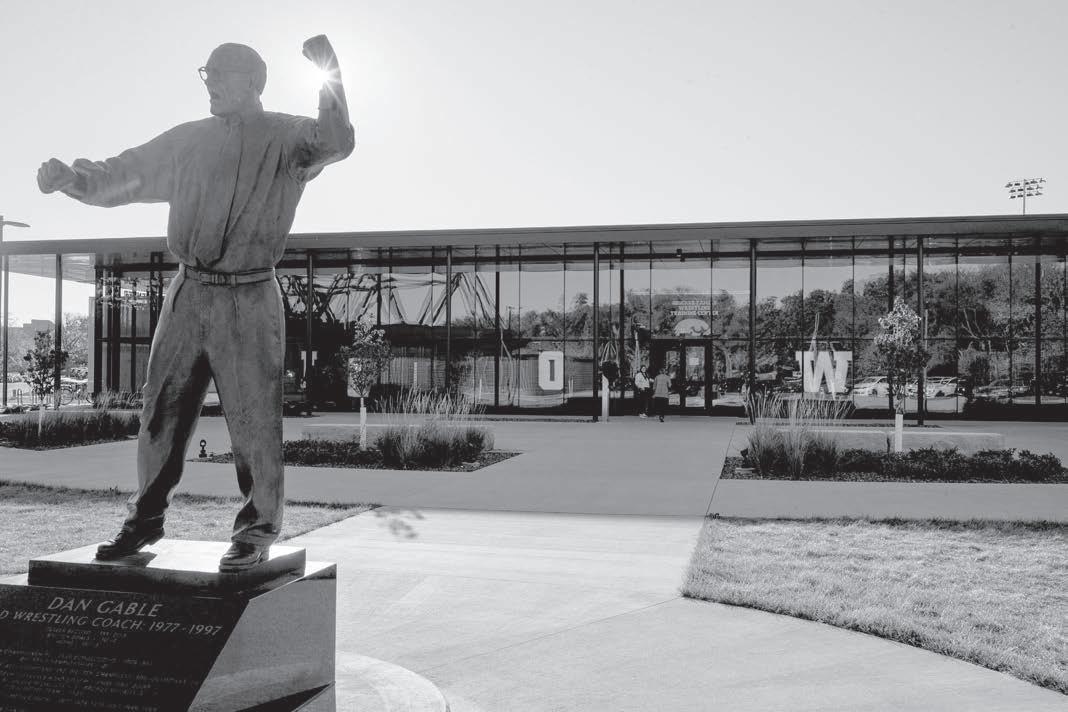

happy for,” Chun told The Daily Iowan. “And they’ve only been supportive since day one in providing us all the opportunities that any other programs have here … I am looking forward to just the forward movement and hopefully momentum with the growth of women’s wrestling.”
Chun’s hope comes as the NCAA announced on Jan. 17 it’s adding women’s wrestling as its latest championship sport. Formerly competing in the National Collegiate Women’s Wrestling Championships, female athletes from Division I, II, and III will compete for NCAA championships — the first coming in 2026.
“The great thing is women’s wrestling is still being added across the country,” Chun said. “The announcement of the NCAA making it a championship sport
begins her second season while putting the team first.
“Just having the same work ethic I had last year,” Berry said when asked how she looks to continue her success. “Pushing myself and my teammates so we can all do better as a whole. If I succeed, that’s one thing, but having the whole team succeed is the bigger thing. My job is to sup port that.”
Young was a first-team All-Big Ten selection following her first season in 2024 after leading Iowa in home runs, slugging percentage, and on-base slugging percentage, making her case of being on the preseason watch list a no-brainer.
While the All-Big Ten team selection was impressive, that accomplishment was never on Young’s mind, an out
only helps support the direction women’s wrestling is heading.”
Over the last year, a handful of smaller colleges and universities have announced the additions of women’s wrestling programs in the near future, including Ithaca College in South Hill, New York, and Norwich University in Northfield, Vermont.
Indeed, per USA TODAY, the National Federation of State High School Associations found the number of high school girls in wrestling quintupled since 2013.
“The numbers don’t lie,” Chun said. “It’s growing. It’s been growing for a long period of time over the decades of girl’s wrestling at grassroots through high school levels.”
Still, it’s hard to imagine the women’s wrestling program will receive enough money to be entirely flexible with Chun’s free discretion, as the bulk of revenue sharing might go to football, basketball,
look that remains this season. Young has struggled to begin the 2025 season, collecting just one hit, but remains focused on helping Iowa win games.

“It wasn’t really something I was thinking about,” Young said. “I was just trying to go out and play good softball for our team. I just try to stay true to who I am.”
Adams, a third-year pitcher for the Hawkeyes, comes off two straight seasons with over 159 innings pitched. The goal is for that experience to transfer into success for the team this season. The junior posted a 2.59 earned run average in 30 appearances last season and also tossed 17 complete games, four shutouts, and one
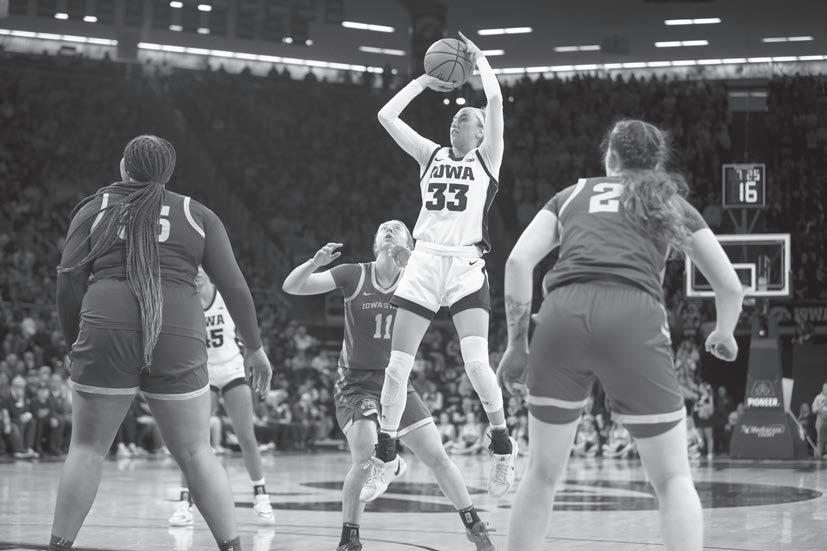
TURNAROUND from 1B

posting 22 points, six assists, and 3.8 rebounds per game during the recent winning stretch. Highlighting this period was a 32-point outing against Nebraska on Feb. 10, her third game of 20 or more points during the streak.
“She’s playing freer,” Jensen said. “We just try to get her to play freer and lighter, and just [trying] all different kinds of mechanisms to do that.”
Arguably, the most important factor was finding that middle ground — riding the waves of the season but staying level-headed through the ups and downs.
“I think the key is always trying as much as you can to stay in the middle,” Jensen said. “Because anything in life, when it shifts too extreme too much, it’s never really great. One of my favorite quotes is, ‘Usually nothing is ever as bad as it seems or as good as it seems, but somewhere in the middle reality lies.’”

Now sitting at 18-8 overall and 8-7 in Big Ten play, Iowa now looks ahead to a tough slate to end the regular season.
The Hawkeyes have three games remaining, one on the road against Michigan, and home matchups against No. 3 UCLA and Wisconsin.
While UCLA is one of the best teams in the country, Rutgers and Wisconsin sit near the bottom of the Big Ten standings and pose favorable matchups.
Michigan recently fell out of the Associated Press Top-25, but the Wolverines still present a tough challenge for the Black and Gold.
“We play in a really, really hard league, and in the middle of this league, if your name’s not UCLA or USC, you look at the scores, and it’s just everybody beating up on each other,” Jensen said. “I’m just so happy that they’ve got a few wins to keep building on.”


and men’s wrestling first. And should any college program struggle to pay its athletes the right amount, they look for one that can.
The House settlement thus has implications for roster sizes and recruitment, too, with so many athletes now demanding money to attend certain schools. It’s great to wrestle with the Tigerhawk across the chest — but how great?
Chun said the women’s wrestling roster cap is now set at 30, before which Chun had no limit for the number of wrestlers she could add across her first two seasons.
“When I got here, it was to my discretion as far as the roster size with intentions of not overdoing it, too,” Chun said. “Our recruiting has looked a little bit different from our first year and second year and even compared to last year.”
Goetz did not respond to multiple interview inquiries from the DI
no-hitter.
Now with Big Ten and national attention on the Hawkeye ace, Adams looks to rely on her teammates to help replicate the career success she’s had.
That mentality has continued Adams’ success into the early portion of the year, as she has yet to surrender an earned run, allowing just four hits in 14 innings of work.
“I just lean into my teammates and know that I trust the defense I have behind me,” Adams said. “That allows me to spin the ball better and locate my spots better.”


Jessy Lane | The Daily Iowan
Iowa guard Lucy Olsen shoots the ball during a Cy-Hawk women’s basketball game between Iowa and Iowa State at Carver-Hawkeye Arena in Iowa City on Dec. 11, 2024. The Hawkeyes defeated the Cyclones 87-75.
Cody Blissett | The Daily Iowan
Athletes and press make their way to the Goschke Family Wrestling Training Center during the second annual Iowa women’s wrestling media day at Carver-Hawkeye Arena in Iowa City on Oct. 15, 2024. The Iowa women’s wrestling team competes in NCWWC Region VII Championships in Indianola, Iowa this Saturday.
Chun
Olsen
Adams
Goetz
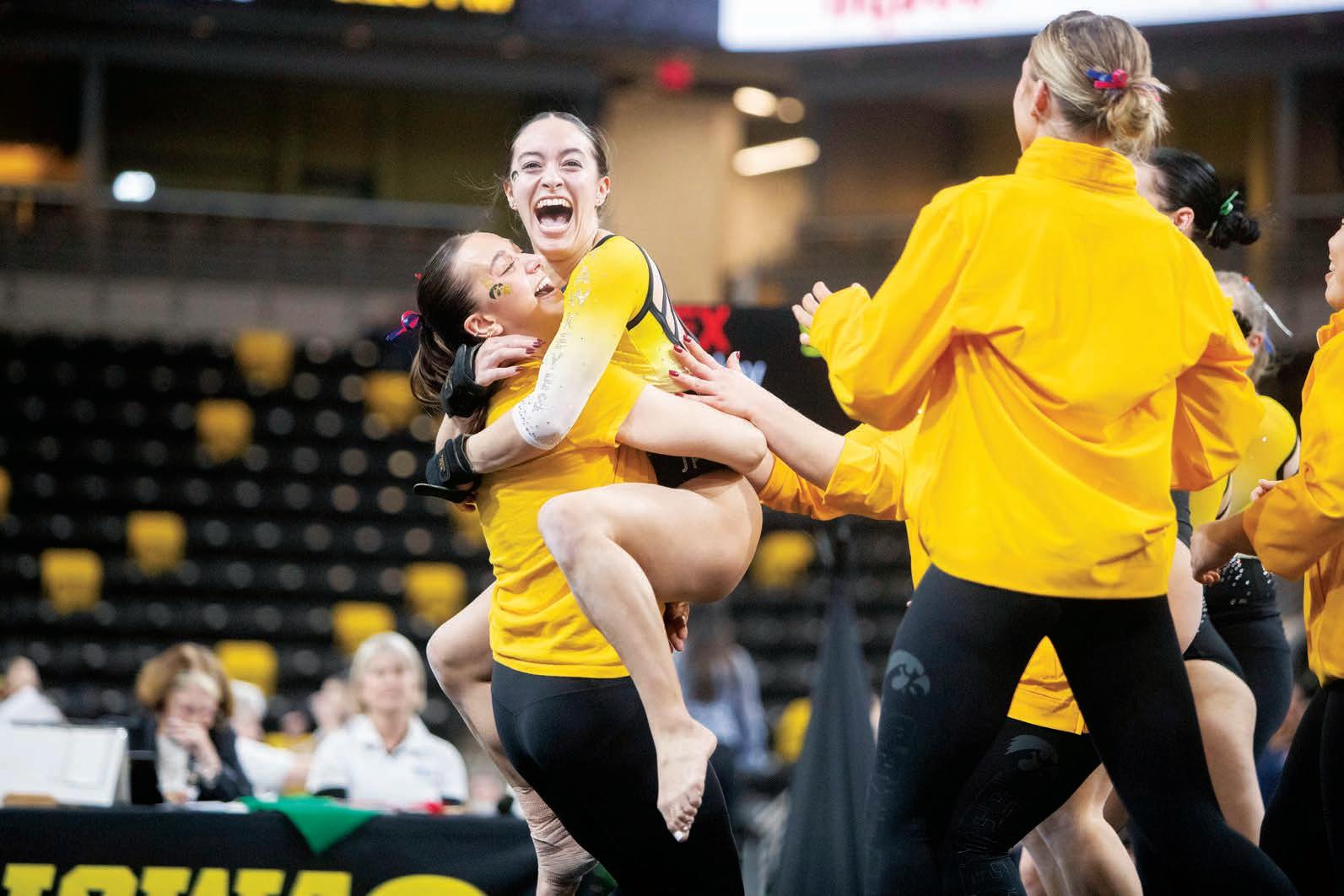
Iowa floors Illinois with upset
The Hawkeyes defeated the Fighting Illini, 196.200-194.975, at Xtream Arena on Feb. 16. Iowa gymnast Emily Erb scored a 9.9750 on floor, tying the program record.
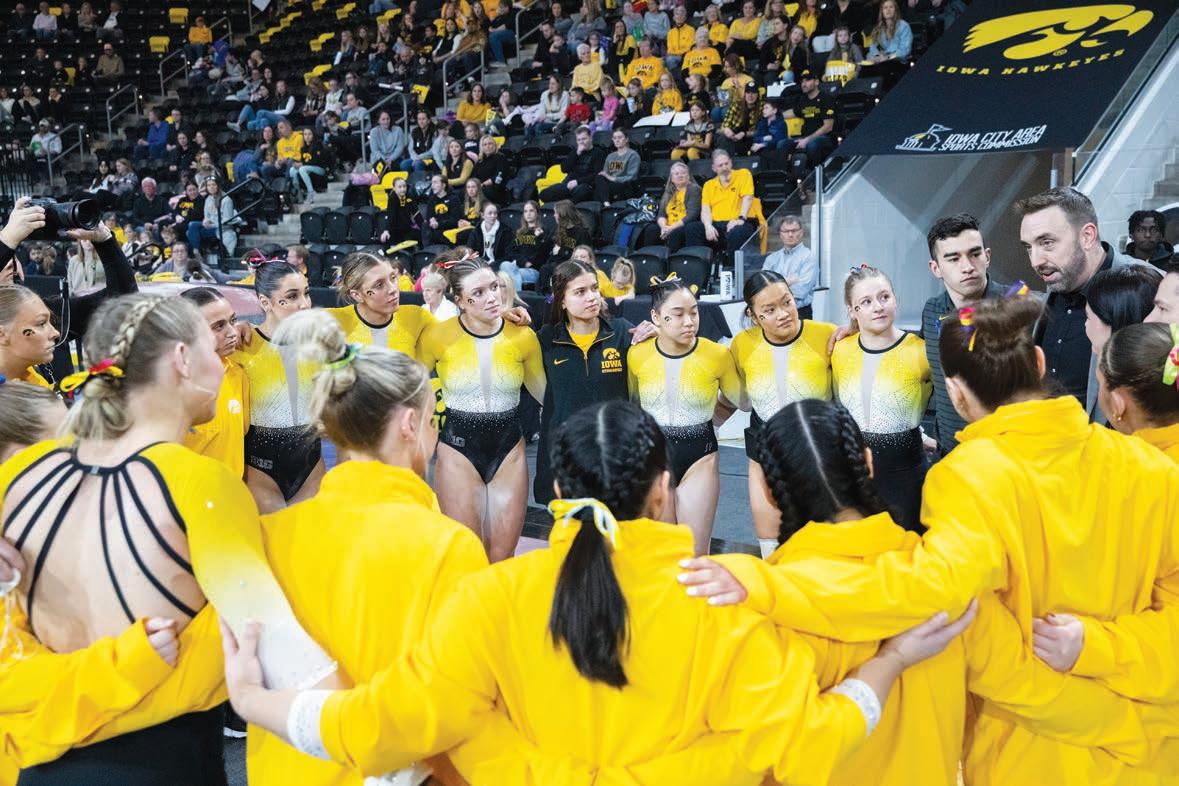
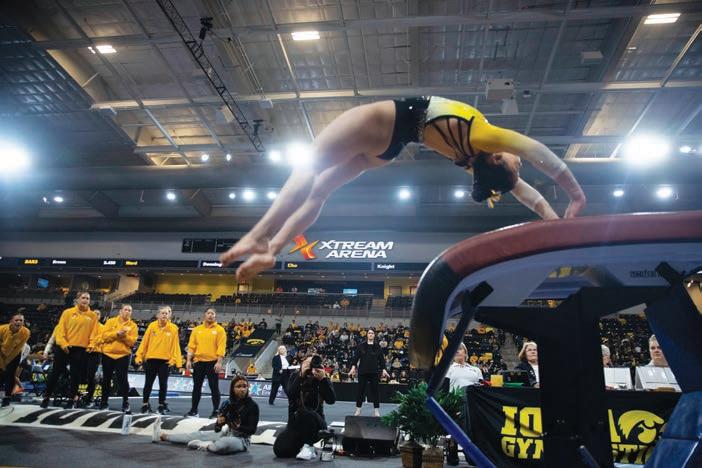
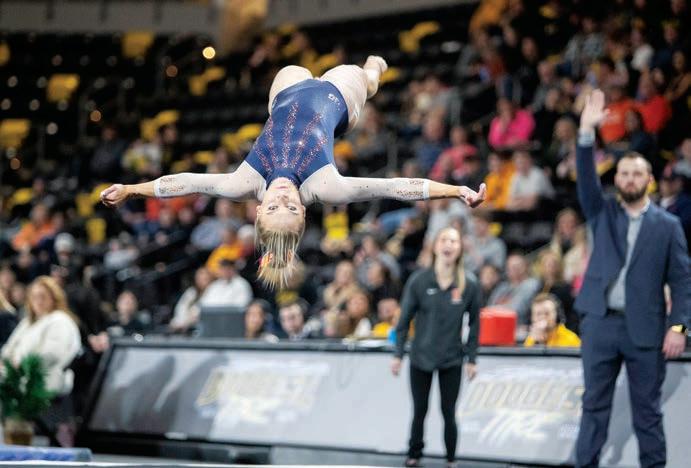
Isabella Tisdale and Clara Jarecke | The Daily Iowan
(Top) Iowa’s Emily Erb celebrates after placing first in floor with a score of 9.975 during a gymnastics meet between Illinois and Iowa at Xtream Arena in Coralville on Feb. 16. The Hawkeyes defeated the Ilini, 196.200-194.975. (Center) Gymnasts and staff huddle following a gymnastics meet. This was Iowa’s second win at home this season. (Above left) Iowa gymnast Aurèlie Tran completes her vault during a gymnastics meet. Tran scored a 9.750 on the vault. (Above right) Illinois gymnast
Emmalise Nock competes on floor during a gymnastics meet. Nock scored 9.875. (Beside) Iowa gymnast Hanna Castillo signs a fan’s poster following a gymnastics meet. Castillo had a vault score of 9.825 and floor score of 9.950.
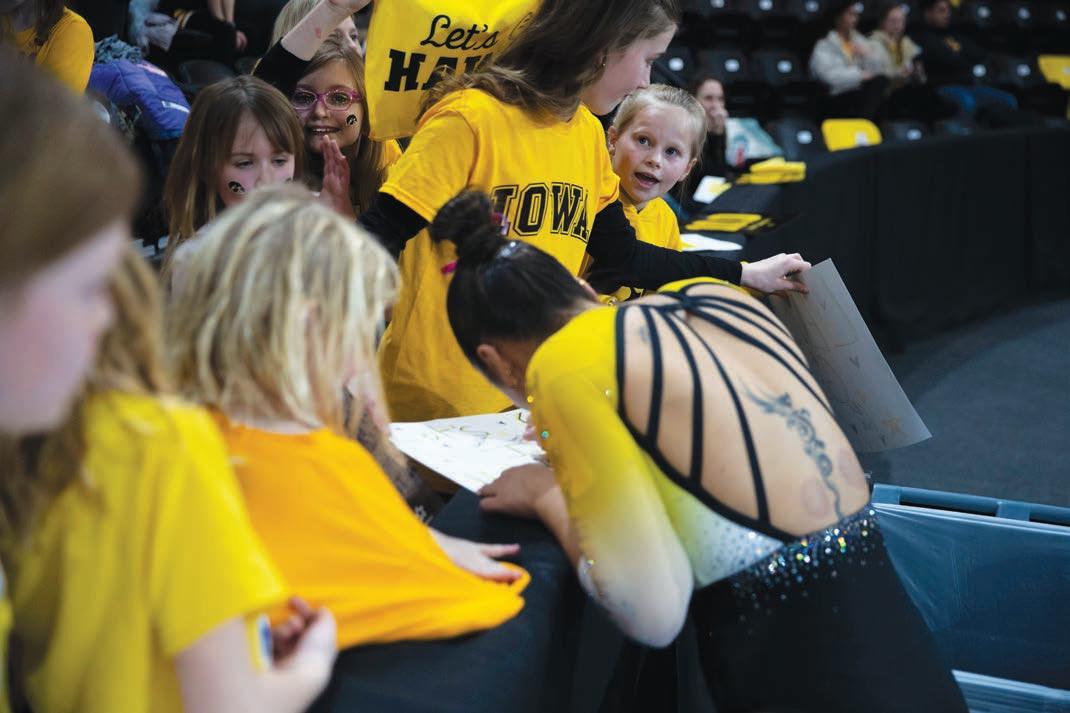
ARTS & CULTURE
WEDNESDAY, FEBRUARY 19, 2025
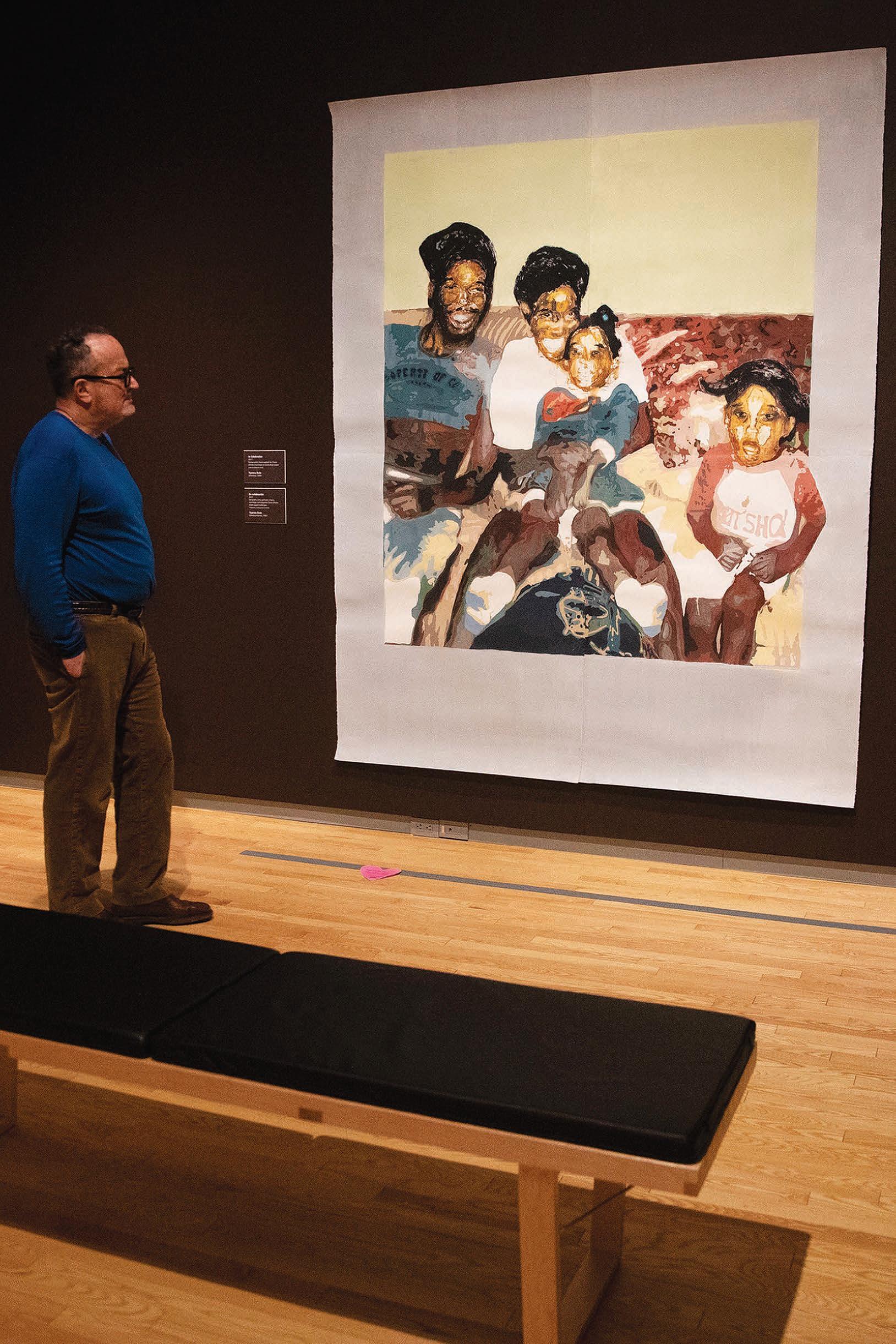
The Stanley debuts ‘it’s a fine thing’ in Iowa City
The Stanley Museum of Art’s new exhibit “it’s a fine thing” explores an underexposed community alongside the National Endowment for the Arts Big Read program.
Grant Darnell
Arts Reporter arts@dailyiowan.com
Riley Dunn Digital Editor riley.dunn@dailyiowan.com
Iowa City has long been known as a city of the arts. This year, however, it’s hosting an unprecedented exhibition spanning multiple mediums at one of the city’s centers for art, the Stanley Museum of Art. Over the years, the Stanley Museum has acted as a reflection and celebration of the abundant art scene in Iowa City. In spring 2025, the Stanley Museum partnered with the National Endowment of the Arts, or NEA, Big Read program.
The initiative, which includes a community-wide reading of the novel “Beloved” by Toni Morrison, will take place at the same time as the Stanley’s latest exhibit, “it’s a fine thing.”
This history of erasure is present both locally and in the story of Buxton, Iowa. Buxton was founded in 1900 and defied the racial norms of the era it inhabited. A coal mining town, many of the Black residents from Buxton held positions of power and influence. However, once the coal mines closed, the town faded into memory — erased from Iowa’s history.
“The opportunity to share that was important to me,” Reynolds said. “And so was trying to understand what that landscape is — to not just be from it, but to gaze upon it.”
The exhibit opened on Feb. 13 to a crowd of a few dozen people who enjoyed a banquet of food and an opening reception that introduced the show and its themes.
Visitors to the Stanley were invited to enter a section of the museum dimly lit and painted in hues of purple. “it’s a fine thing” adorns itself with different pieces from the Stanley and UI Special Collections and Archives. Each piece is meant to celebrate the resilience and creativity of Black Midwestern artists.
“it’s a fine thing” is curated by Katherine Simóne Reynolds and supported by a cohort of advisors. Through it, Reynolds seeks to explore the landscapes and narratives of the often-overlooked Black Midwest. She also views the exhibit as a way to examine the residues erased from the pages of history.
One piece, for example, comes from the scrapbook of Patrobas Cassius Robinson, a student who attended the UI from 1923-27. The photo acts as a time capsule into the early 20th century and into what life for Black students may have looked like at the time. Robinson’s photo is included on the front of the light violet brochures available at the Stanley front desk, which act as a short guide to the exhibit.
While planning the exhibit, Reynolds drew upon the experiences and ideas of her curatorial cohort. Members of this cohort include Kemi Adeyemi, Angel Bat Dawid, Ashley Howard, Mpho Matsipa, and Terrion L. Williamson.
“I was thinking of their eclectic backgrounds. There were some musicians, writers, thinkers, scholars, architects — all Black women and historians,” Reynolds said. “Working with them through the collection the Stanley has was a little difficult, if only because the Stanley doesn’t necessarily have a lot of specific Black Midwestern artists.”
Reynolds said her work with the cohort helped her to think more expansively about things, allowing her to include the Rust Belt in the area she was examining



PROFILE
Local bead store owner Karen Kubby captivates with love of beadwork
Artist and co-owner of Beadology Iowa recalls her discovery of love for beadwork and its influence on her bead store.
Isabelle Lubguban Arts Reporter arts@dailyiowan.com
Hannah Childers Arts Reporter arts@dailyiowan.com
When Beadology — formerly Dawn’s Hide and Bead Away — was sold in 2008 to sisters Karen and Laurel Kubby, it gradually became Iowa City’s hotspot for bead art.
When she was a child, co-owner Karen Kubby was exposed to numerous art forms by her grandmother. After trying a variety of mediums, beadwork stood out.
“My grandmother was a professional seamstress working for herself in Des Moines,” Kubby said. “She had that spirit, was a strong, stubborn independent person with a lot of skills. When I would go visit her, there were beads around.”

‘Design
for Living’ doesn’t live up to its stellar script
Awkward performances and a cramped stage make this play a dissatisfying experience.
Laurel Preston Arts Reporter arts@dailyiowan.com
“Design for Living,” which opened Feb. 14, is a raunchy comedy filled with queer love and a risqué throuple presented by Dreamwell Theater at the ArtiFactory.
The script’s subject matter is titillating and salacious, to put it lightly. Playwright Noël Coward beautifully paints the intertwining lives of three people trying to have love and careers.
Although the script is wonderfully written, this element was muddled by the directorial style and the interesting acting choices made by the people on stage.
Viewing this play, it felt like the audience had to stumble through the dull and unexplained lives of characters Coward wrote to be interesting. The lack of dramaturgy in this piece was apparent and prohibited the actors from understanding what they were saying. There were moments of wonderful hilarity quickly snuffed out by the overcrowded stage. Other moments fell flat because the actors never felt grounded in the piece, as if they weren’t given clear direction.
The production did certain moments very well with the notes of farce written by Coward able to occasionally shine. But with those moments came others where the actors seemed awkward on stage, not remembering their lines or not meshing with the script.
The whole piece came off as something one would watch while attending a high school play they were dragged to. The set was distractingly unprofessional, making it seem like the crew didn't know how to work with the small stage’s limits.
The set gave off a cozy feel, as though the audience had just stepped into the apartment of a lowly artist. Although the walls were a horrendous shade of pink, the set in act one felt true to form.
But as we traveled through the world of the piece, the apartments and people got more and more wealthy, and the set design seemed to fall more and more flat. The needless scenic transitions to change one wall to make a window big -
ger seemed redundant and not properly thought through.
Large pieces of furniture were moved on and off stage, which took up the full intermission times to complete stage transitions. It felt as though when building the set for this play, designers did not consider the space they had to work with and tried to put on a normal proscenium play.
The costumes of the piece were well done. The acquisition of wealth we see in each character as they become more and more successful in their endeavors shows through their clothes and is easily clocked by the audience.
The sound and light design were also effective with the space given. Something to note in transitions between scenes — ones that were not filled with scenic movement — the stage would fall pitch black. This caused the actors to fumble their way around the stage, which was yet again another war flashback from high school theater.
“Design for Living” is a wonderfully written play filled with moments of comedy sure to have you laughing, crying, and in love. Which is why, if you haven’t, you should go and read the play. This production felt poorly directed and was filled with redundancy. The actors’ awkward interactions and the sets were utterly unsatisfying leaving me ultimately let down by this three-hour play.

Her grandmother wasn’t the only influential member of her family, though. Her two sisters often crocheted, her dad taught them how to spool skit, and their mom taught them how to craft rugs.
Kubby was also the one who got both
Free
of her sisters into beading. One sister, Laurel, who is also a co-owner of Beadology, did not start that craft until later in her life, while Karen has been crafting for over 50 years.
Karen Kubby worked at the Iowa City Emma Goldman Clinic for 10 years when she declared she wanted to do more artwork.
“I approached [Dawn’s Hide and Bead Away] and said, ‘I want to teach,’” Kubby said. “And they said, ‘Well, we don’t want you to teach the store, we want you to own the store.'”
After purchasing the store, the sisters discovered the original business had been financially failing. It took 18 months, but the pair got it back into shape.
The store had originally been located across the street from The Englert Theatre, where it remained for 15 years after the Kubby sisters purchased it. Three years ago, the Kubby sisters moved the store to its current location on Clinton Street.
Beadology features a wide variety of materials from long strands of freshwater pearls to bowls of stone beads and bags of the tiniest Delica beads. The store is full-service, meaning they sell supplies, the tools to use the supplies, classes, repairs, and more.
Beadology is the only bead store in the state of Iowa after the closing of another bead store, Grandma’s Attic, in 2024. While this is a source of pride, Kubby finds it a little saddening.
“People have to travel far to get to a place where they can see
week
things themselves,” Kubby said. “Especially if you’re buying a high-end stone, you want to look at it before you [buy it].”
Kubby held an exhibition back in October in which she, along with other staff and guest instructors, rotated an exhibition of their work. They will continue to do so once a month.
“It feels nice to see my things gathered,” Kubby said. “You can really start to see a flavor of [my artwork] that is different than Alyssa’s or Laurel’s. We might be using the same materials, but there’s different types of beading techniques.”
Alyssa Jakowchuk is the assistant manager at Beadology and specializes in stringing and crafts of multi-stranded creations. Beadology sources materials from all over the world, and Jakowchuk alluded to the variety of materials used to make beads.
“This man and his daughter used to go hunting, and they would bring us the antler tips to make into beads,” Jakowchuk said, referring to one particularly unique material.
Kubby herself specializes in a type of bead-weaving known as cubed right-angle weaving, or CRAW.
“[CRAW] is a stitch that I’ve been obsessed with for over 15 years.” Kubby said. “I just keep developing new techniques and new patterns.”
As a local business owner, Kubby attributes commitment as the primary factor in her success as a businesswoman.
“You have to build trust,” she said.
of arts events
offer chances for discovery
X Marks the Arts organizes week of free experiences across Iowa City venues. LIST
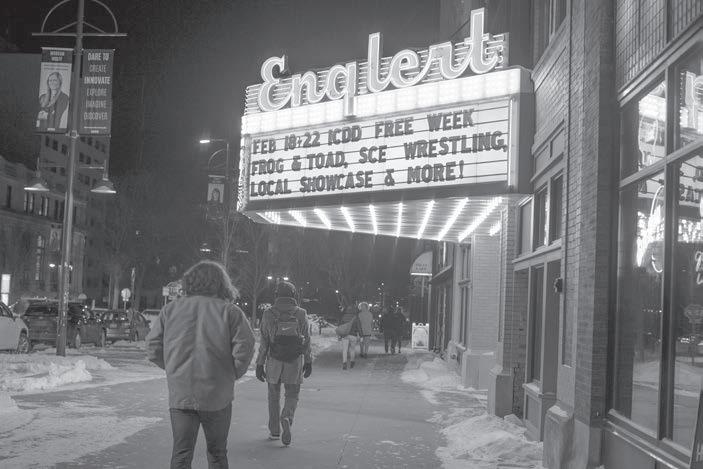
Charlie Hickman Arts Editor charlie.hickman@dailyiowan.com
After Iowa City has been tormented by snow storms, sheets of ice over the road, and riotous celebrations watching former Hawkeye Cooper DeJean score a pick-six in the Super Bowl, venues around town are offering a more artistic escape.
The Iowa City Downtown District’s X Marks the Arts program is a community-building initiative meant to encourage people to check out experiences around the city they wouldn’t normally look for.
This week, the program’s biggest event so far will give people a completely free way to experience the arts and culture of Iowa City. That’s right — the X Marks the Arts Free Week begins Feb. 18 and runs through Feb. 22.
With so many options, it can be difficult to find the right places to spend your time this week. This list seeks to provide inspiration and point out some of the unique opportunities that Iowa City will offer free of charge this week.
Ped Mall documentary at FilmScene - all week
Every day of Free Week, FilmScene will show a new local documentary titled “We Always Come Here,” a retelling of the history of Iowa City’s Pedestrian Mall. The film will be on a loop in the Ped Mall location starting at 11 a.m. every day until 3 p.m.
UI Symphony Orchestra at Voxman Music Building - Feb. 19 at 7:30 p.m.
The first concert of the year for the University of Iowa Symphony Orchestra is free to attend and stream online. For the first installment in their program, they will perform “Requiem to Revival” from Gram-
my-winner Jessie Montgomery. The event is a perfect way to get immersed in contemporary classical music.
SCW Pro Wrestling at The Englert Theatre - Feb. 20 at 7 p.m.
Since 2003, SCW has been promoting independent, professional wrestling across Iowa. The organization pulls talent from Davenport’s Black and Brave Wrestling Academy and puts on shows at venues across the state. This week, they’ll be taking the fight to The Englert Theatre for a free showcase of pro talent.
Know Iowa’s birds at the Iowa City Public Library - Feb. 22 at 1 p.m.
As a part of the Iowa City Public Library’s “Wintering Together” series, a collection of events meant for adult audiences have been hosted in the library’s event space throughout the month. This week, the library will feature an introductory bird-watching course to teach residents how to recognize the birds they see outside their windows every day. In addition, other more advanced bird-watching resources will be recommended for those wishing to pursue the hobby.
This week offers a multitude of various events across venues all around town. Events like this don’t come around often, but the X Marks the Arts Free Week goes to show how vibrant and accessible the Iowa City arts community can be.
Ava Neumaier | The Daily Iowan
The marquee for the X Marks the Arts Free Week of events is hung up on The Englert Theatre in Iowa City on Feb. 13. X Marks the Arts is a community-building program designed to encourage event-goers to check out new events around Iowa City.

— an area that may not always be associated with the Midwest.
“When it comes to geography, we had to think of expansiveness, like in the migration of Black people into other spaces, whether it be the Rust Belt or other post-industrial landscapes,” Reynolds said.
One of Reynolds’ favorite aspects of the exhibit is its color palette, inspired by photos from her grandmother’s house. She said she has also enjoyed meeting the Iowa City community and viewing all the Stanley offers through special collections.
“It’s been really cool to be able to work with certain legends of Black art, work, and creativity,” Reynolds said. “These are the things I’ve been able to uncover. There are all these levels and layers of uncovering residue, which I’ve always loved with the process of curatorial work.”
At the same time “it’s a fine thing” makes its debut, the Stanley Museum will also be participating in the 202425 NEA’s Big Read event, which features a list of 29 books. Through the event, participating cities are rewarded with a grant and tasked with bringing together their communities through reading.
Derek Nnuro, the Stanley’s curator of special projects, believes Toni Morrison’s “Beloved” provides a great historical anchor for the topics explored in “it’s a fine thing.”
“I don’t think any other book is as perfect as this book for this show and for what we are seeking to do, which is to expand the exhibition’s narrative into a discussion about the historical origins of the Black Midwest,” Nnuro said.
Written in 1987, “Beloved” examines the legacy of slavery and racial history in America. It’s a challenging but important read based on the true life of an enslaved woman.
Students and community members living in Iowa City could pick up a free copy of the novel from either the Stanley Museum or 12 other participating locations.
The program launched on Jan. 20 during Martin Luther King Jr. Day and concluded on Feb. 12 just before the opening of “it’s a fine thing.”
Throughout the spring, Nnuro will host four separate discussions, each offering a conversation about parts of the novel and a few of the works from the “it’s a fine thing show.” The first discussion was hosted on Feb.15, and the others will be held on March 8, April 5, and May 10.

By May, Nnuro hopes to examine every piece within the show and connect it to the novel.
“I want people to come to all of them, but I think that’s a tall order. So, I love that the objects allow me to continue the conversation from each session to the next,” Nnuro said. “Anyone can drop in because each discussion is going to be very much individualized.”
The Stanley’s approach and care put into the “it’s a fine thing” exhibit and “Beloved” reading is in keeping with the museum’s desire to entwine art and expression within the broader Iowa City community.
“This is the perfect time for this show to be happening in this city and this state,” Nnuro said.
Several Iowa City businesses participated in sharing free copies of “Beloved.” Jason Paulios, the adult service coordinator at the Iowa City Public Library, spoke about his experience as their “contact person,” communicating with the Stanley staff to distribute copies of the book.
“These big community read events are
a nice focal point for the community, for gathering, social interaction, engagement with either people,” Paulios said. “But it could also be a chance to meet new people and step outside your comfort zone with literature. Maybe [“Beloved” is] a title you wouldn’t normally choose to read, but this way your eyes are open to a new work.”
Paulios emphasized that the Big Read offers a unique opportunity for community members to engage with the arts, explaining how someone might be moved by a book passage and then feel compelled to attend one of the Stanley discussions, eventually making their way to the exhibit.
“It’s a good excuse to get together and learn a lot more about your world,” he said.
Paulios also noted Iowa City’s strong literature background and why it was chosen as one of the 62 worldwide locations to host the Big Read.
“We have a really strong library system in this region and historically strong libraries in Iowa as well,” Paulios said, also noting Iowa City’s UNESCO City
PS1’s latest exhibit showcases
of Literature designation. “[Iowa City] would have been an easy one for NEA to choose, I would think.”
Paulios is familiar with Toni Morrison’s work but hasn’t read “Beloved” in many years. He’s looking forward to reading it again in conjunction with the city’s various events.
“I remember being impressed with it when I read it, of course, and it’s been long enough that I need to revisit [it],” he said, emphasizing Morrison’s influence both as a writer and a cultural icon. “I think she was an intellectual American looked up to.”
Reynolds is excited to share her own work with Iowa City and celebrate the fruits of four years worth of hard work and planning.
“It’s pretty incredible and poignant at this time to really discuss the complexities of erasure but also the complexities of joy and desire,” Reynolds said. “Being able to do so at this exhibition, particularly as a Black woman and thinking of the ambitions of other Black women — I’m just trying to manifest that as much as possible within any space I go to.”
the complexity of drawing
Public Space One’s recent exhibition features works by four artists utilizing various art forms.
Hannah Childers
Arts Reporter
arts@dailyiowan.com
Art spans many different mediums, from pencil to textiles and ink. All of them were featured in Public Space One’s latest exhibition, “Drawn
Between: Possibility and Inevitability.”
Curated by artist Jeremy Chen, this exhibit features drawings by four artists: Jen P. Harris, R. Kauff, Kathranne Knight, and Ajdin Kulić. According to Chen, the exhibit takes its title from a statement by artist William Kentridge that drawing is always hovering between possibility and inevitability.
Chen met Kauff and Harris at an Intro to Drawing class he was holding here in Iowa City. They were guest speakers at his class and gave him the idea to do a project involving drawing.
“I wanted to talk to these artists more because it gave me so many ideas about drawing, and it gave me so many questions about drawing,” Chen said. “Wondering what drawing is, what it
does, how I use it, how other artists use it.”
Drawn Between is a complex and colorful exhibit. Each artist’s works are displayed on separate walls. Yet collectively, they meld into a beautiful wave of color. Along with featuring various mediums, the artists’ works display a range of colors and unique patterns.
Kulić’s works are made from different textiles with rich hues centered around the theme of life. Their most notable work is a piece entitled “whirl-pile/ wishing pool for seeds,” a textile square consisting of a rich, deep red circle settled on a warm brown background that includes date pits as one of its media.
“This exhibit made me think about evolution,” Kulić said. “Personal evolution as well as artistic evolution and creative evolution.”
Knight’s works center around themes of light with bright, vibrant colors. One of her works, “RISO Thinking, Rolling Landscape with Connector Holes,” reminded me of a delicate pink
sunrise, the bright yellow sun drawing my eyes in immediately. In her works, every dot and line serve a purpose, and I could see each one. Harris chose graph paper, which makes for an interesting medium. Their works consist of squares of bright color that make complex, colorful patterns on the paper. In the middle of each of their works, I could spot an outlined figure; most notably in “untitled (bird),” which shows a bird outlined in silver poised to fly.
“For me, drawing is also the ground that everything else stands on,” Harris said. “It’s also the approach that I take when I’m working with paint or with yarn. I’m also drawing with it.”
In their works entitled “memo drawings,” artist R. Kauff focuses on the art form of writing, using phrases such as “WHY WAIT W/ HY WAIT WHY/ WHY WAIT W/ HY SUCH WEI,” letting the audience’s minds take in the words and fill in the incomplete phrases.
While traveling between the two rooms, a table offers take-home prints by each artist in the styles of the works
displayed in the exhibit.
“For me, [this exhibit] is a way of thinking, a way of understanding my thought process and then reflecting on that and noticing how it can change,” Harris said. “It’s just such a powerful experience to have.”
As part of the exhibit, free public drawing workshops will be offered from 1-4 p.m. on Saturday, Feb. 22 and Saturday, Mar. 1.
“I would like [the audience] to appreciate how each of these artists is focused on drawing and very committed to their drawing practice,” Chen said.
“Also, expanding ways that drawing works for them, ways that drawing can be for all of us.”
A colorful, reflective exhibit, “Drawn Between” reminds viewers of the power of a blank canvas and the simple medium and shows us what happens when we draw.
“Drawing is so accessible, and it is such a human practice,” Kulić said. “I hope [the exhibit] helps people catch their breath and reconnect with their bodies.”
Clara Jarecke | The Daily Iowan
Guests watch the short film in the room during the exhibition opening of “it’s a fine thing” at the Stanley Museum of Art on Feb. 13, 2025. The exhibit opened concertedly with a wider Iowa City celebration that began during Martin Luther King Jr. week.
Clara Jarecke | The Daily Iowan
Exhibit curator Katherine Simone Reynolds and Stanley Curator of Special Projects Derek Nnuro pose during the exhibition opening of “it’s a fine thing” at the Stanley Museum of Art on Feb. 13. The exhibit runs from Feb. 13 to July 20.
The Stories Project gives new vision for vacant lot
As the city decides the fate
Kate Wolfe Arts Reporter arts@dailyiowan.com
Since the downtown Iowa City U.S. Bank drivethrough was demolished in 2021, 21 S. Linn St. has sat vacant. Rather than fading into the backdrop, however, the barren lot jumps out at passers-by, its stillness contrasted by the vibrant lights from AlleyCat, The Englert Theatre, and the bustling restaurant windows surrounding it.
However, the lot is not destined to remain empty for long. After submitting a request for redevelopment proposals in September 2024, the Iowa City City Council is now determining what the future holds for the space.
One vision for the site is the Stories Project, an immersive and visually diverse museum celebrating storytelling, the written word, and Iowa City’s status as a UNESCO City of Literature.
“Storytelling in the written word is an endangered species right now. Even though people take in stories perhaps more than ever, they spend fewer hours actually reading.
The museum’s mission is to engage people and inspire them,” Stories Project Executive Director Brent Stinski said.
The council is currently reviewing proposals from three Iowa-based companies — Grand Rail Development, Iceberg Development, and Salida Partners. Grand Rail and Salida both include the Stories Project as a flagship tenant in their

proposals, which envision the museum as part of a larger, multi-use space.
The idea for a museum centered on storytelling was originally conceptualized in 2008 but was abandoned due to a lacking funds after the 2008 floods.
Although Stinski was not involved in the project’s genesis, watching the devastation of the floods on the Iowa City community and the evolution of the art industry as the community rebuilt played a key role in his decision to act.
“When the floods happened in 2008, Hancher Auditorium was destroyed. The Stanley Museum of Art was destroyed. It was a real low point for the arts in Iowa City,” Stinski said.
“But as Iowa City rebuilt, The Englert got renovated, Hancher reopened, and we even expanded into new art projects like FilmScene. I was just astonished to see these

successive waves of arts facilities expanding our arts economy.”
For the Stories Project, the goal is more than just filling an empty lot. It is about preserving and expanding upon the rich history of art and creativity already present in Iowa City. Simeon Talley, the project’s political relations and community outreach director, sees the project as a key to shaping Iowa City’s legacy.
“I moved here several years ago, but staying was a deliberate choice for me. What keeps me here is the opportunity to contribute to making Iowa City a more inclusive, attractive place,” Talley said. “We want this city to be an interesting, bright oasis of arts, creativity, and people.”
A review of the projected economic impacts of the project, prepared by Community Attributes Inc., estimates the Stories Project could generate

$21.7 million annually if it meets anticipated attendance goals.
Geoff Fruin, Iowa City’s city manager, stressed the importance of choosing the right proposal for this prime location.
“[The council] is looking to identify which project complements what we have downtown already,” he said. “It’s not just about being successful on its own but about helping surrounding businesses thrive as well.”
Although a definitive date for the decision has not been set, the council will next discuss the matter on March 11.
Even if the Stories Project doesn’t come to fruition at 21 S. Linn St., Stinski remains optimistic.
“On the national stage, Iowa City was born to play this role,” Stinksi said.
“We’re celebrating decades of writing programs, writers, and creativity that have shaped this city.”
LOCATION OF POTENTIAL PROJECT
The empty lot at 21 S. Linn St. could house a museum.



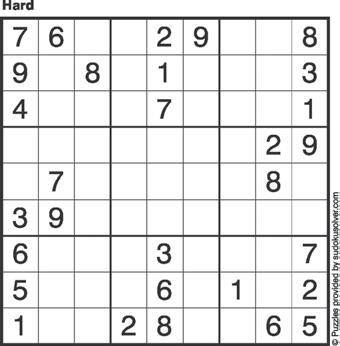

Map by Ana Rivera | The Daily Iowan
Ava Neumaier | The Daily Iowan
Pieces of art hang on South Linn Street in Iowa City on Feb. 11. The art is a part of the Stories Project, an interactive museum created by Brett Stitski.
